Create a free profile to get unlimited access to exclusive videos, sweepstakes, and more!

The 15 greatest Star Trek: Voyager episodes, ranked
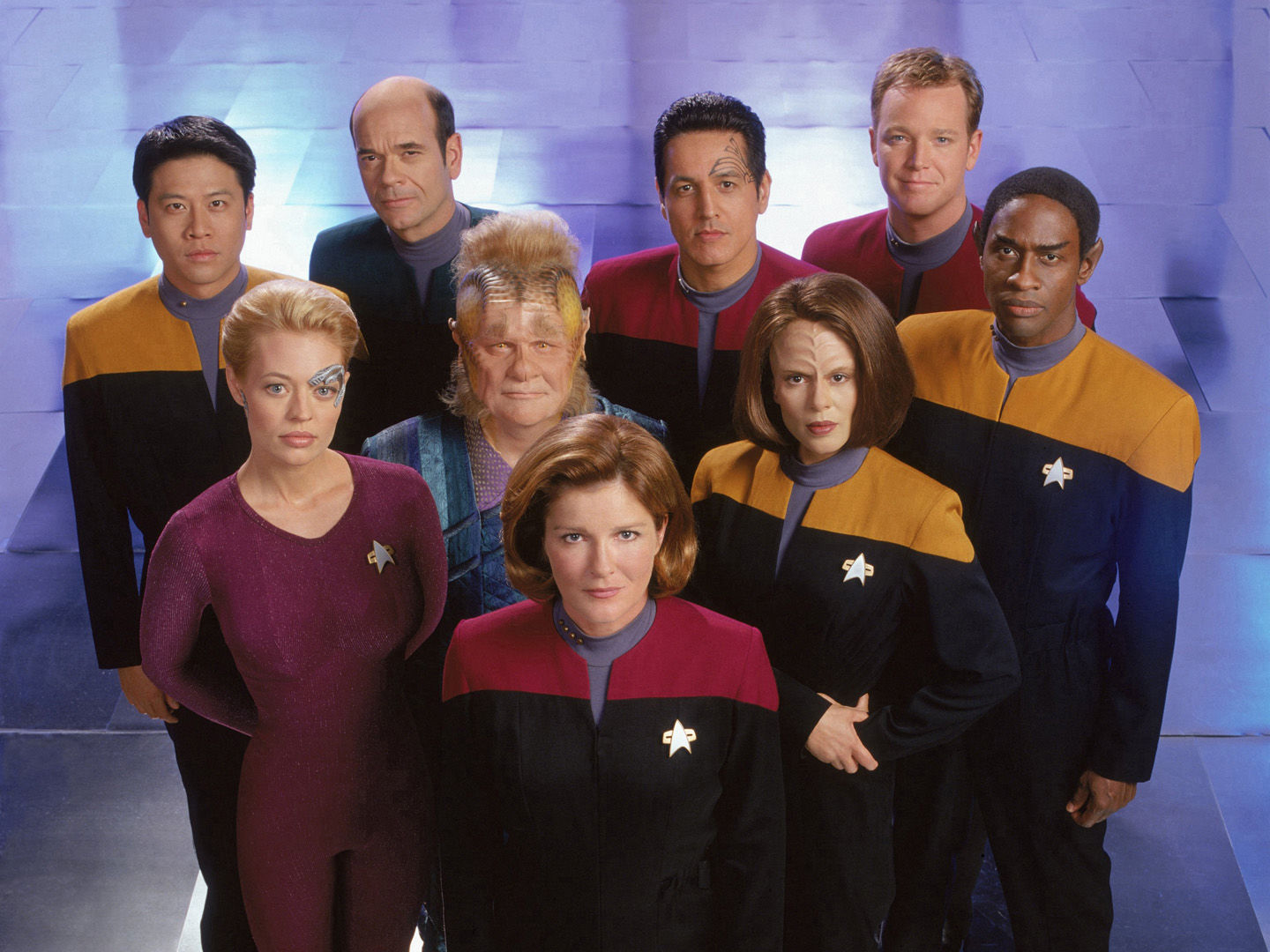
Credit: CBS
Star Trek: Voyager was a series with a great premise and stories that somewhat frequently — but not always — lived up to it.
25 years ago today, Voyager premiered with the two-hour pilot "Caretaker" and forever changed the franchise with its introduction to the first female Captain, Kathyrn Janeway (a perfect Kate Mulgrew). Resilient, Janeway was unyielding in her efforts to get her untested crew home after they were zapped to the uncharted Delta Quadrant, 75 years away from Earth. Starfleet personnel mixing with former officers/current members of a resistance group known as the Maquis promised great, "only-on- Star-Trek " conflict — coupled with a ship stranded from the usual resources and aid afforded Kirk and Picard’s Enterprises.
Sadly, Voyager never fully embraced the full potential of that core conceit, leading Voyager to spend a big chunk of its seven-season run feeling like " Star Trek: The Next Generation lite." The ship was usually always fixed the next week if the previous one had it under attack or badly damaged. And the crew seemingly didn't mind too much about taking detours to explore and map this unknown area of space instead of doing what normal humans would — less sightseeing, more getting this 75-year journey underway as soon as possible and without distraction.
Despite Voyager 's uneven feel, when the show hit its stride, it produced some of the most entertaining hours the genre has ever seen. To celebrate Voyager 's 25th anniversary, here are the 15 best episodes.
15 . “Caretaker” (Season 1)
Voyager 's feature-length series premiere is one of the strongest pilots ever for a Trek show. Starting off at Deep Space Nine before stranding Captain Janeway and her motley crew of Maquis deserters in the Delta Quadrant, "Caretaker" has a riveting first half, peppered with exceptional character interplay. Then the pacing and tension slow in the second hour where we spend way too much time with an alien race that seems to have modeled itself after the citizens of Mayberry and The Waltons.
14 . "Eye of the Needle" (Season 1)
"Eye of the Needle" has a bittersweet twist that ranks up there with some of the best Twilight Zone endings. With the help of an anomaly via a wormhole, Voyager is able to communicate with a ship in the Alpha Quadrant. The catch? It's a Romulan vessel and not one in the same time as our lost heroes.
13 . "Dreadnaught" (Season 2)
If Speed and Runaway Train had a kid, it would be "Dreadnaught."
This compelling and tense hour of Voyager centers on engineer — the Klingon-Human Torres — struggling to reprogram a deadly missile designed by her enemy, the Cardassians, before it destroys a planet. Most of the hour is just Torres in a room, talking to a computer, and it is some of the most harrowing scenes in all of Trek history.
12 . "Mortal Coil" (Season 4)
Neelix, as a character, struggled to find solid footing among the ensemble jockeying for meaty storylines. But "Mortal Coil" remedies that with a dark, brooding storyline that takes on the afterlife and Neelix's near-death experience with it. After realizing the afterlife his culture believes in isn't really there, our favorite Talaxian suffers a heartbreaking existential crisis.
11 . "Tinker, Tailor, Doctor, Spy" (Season 6)
Veteran Star Trek: The Next Generation writer Joe Menosky — with a story from cartoonist Bill Vallely — crafted one of The Doctor's funniest outings, as the sentient hologram struggles with the hilarious consequences of giving himself the ability to daydream. The good doctor's fantasies catch the attention of an alien race's surveillance, but they think they are real — which brings about some trouble for the crew. How the Doctor saves the day is one of the best scenes Voyager has ever done.
10 . "Blink of an Eye" (Season 6) / "Relativity" (Season 5)
"Blink of an Eye" has a perfect Trek premise — Voyager orbits a planet where time passes differently for its inhabitants that for the ship's crew, so Janeway is able to watch this society evolve in, well, a blink of an eye.
This first contact scenario allows the show to invest the "explore strange new worlds" mandate with more emotion and nuance than Voyager usually affords its stories, giving fans a surprisingly poignant episode that still holds up to this day.
And despite time travel being a popular narrative trope in Star Trek , the show never failed to find new ways to explore and subvert it. "Relativity" is a fun, ticking-clock caper that sends former Borg drone Seven of Nine (Jeri Ryan) back in time to prevent the destruction of Voyager. Co-written by Discovery co-creator Bryan Fuller, this exciting episode keeps you at the edge of your couch cushion with an impressive act four twist.
09 . "The Equinox, Parts I & II" (Seasons 5 & 6)
In a plot worthy of a Star Trek movie, Janeway and her crew encounter another starship stuck in the Delta Quadrant, The Equinox. Commanded by a battle-hardened, Ahab-like figure, Captain Ransom (John Savage), The Equinox plots to hijack Voyager and strand her crew aboard their dying ship — in order to escape a race of subspace aliens that have been plaguing them.
Part of the fun of this excellent two-parter is never really knowing for most of its run time where the plot is going to go — for a moment, we actually think Janeway will lose this one.
08 . "Deadlock" (Season 2)
"Deadlock" is one of the few bright spots from Voyager 's bumpy early days. While the episode could take place on any of Trek 's ship-based shows, the stakes feel higher and for Janeway and her crew as they must work with those belonging to an alternate version of Voyager to get out of trouble.
When our Voyager — Voyager Prime — becomes fatally disabled, Janeway volunteers to sacrifice her ship so the other Voyager can go on. How Janeway handles the idea of this sacrifice results in the Ensign Harry Kim (Garret Wang) the show started with being replaced by his doppelganger.
07 . "Scorpion, Parts I & II" (Seasons 3 & 4)
"Scorpion" is action-packed Season 3 finale/Season 4 premiere that kicks off with a hell of a hook for a teaser: A small fleet of Borg cubes easily destroyed by an offscreen threat.
That threat is revealed to be Species 8472, a long-standing rival of the Borg in this quadrant of space — the only thing the Borg are afraid of. Enter Seven of Nine (Jeri Ryan), a Borg attache who becomes a remember of Janeway's crew as Voyager teams up with the enemy of their enemy to both defeat the Borg and shave some time off their trip home.
"Scorpion" represents a turning point for the series and for the franchise, with the introduction of the instantly-iconic Seven — another member of Trek’s deep bench of alien characters struggling to learn what it takes to be human. Or, in Seven's case, rediscover her humanity.
06 . "Counterpoint" (Season 5)
"Counterpoint" (Kate Mulgrew's favorite episode) is arguably Voyager 's most underrated episode, with a storyline whose elevator pitch could be "The Diary of Anne Frank" in space.
Voyager is secretly providing safe harbor to a group of telepaths being hunted by an alien race that hates them. (So, basically, Space Nazis). When the latter's charming leader defects to Voyager, and sparks a relationship with Janeway, it's instantly fraught with suspicion that boils over into bittersweet betrayal. The hour is an acting showcase for Mulgrew, as she pushes Janeway to uneasy places with the hard choices only this captain can make — and learn to live with.
05 . "Latent Image" (Season 5)
The most successful medical storylines on Star Trek are those that tap into moral/ethical dilemmas with a tech twist. In "Latent Image," the Doctor finds himself caught in the middle of both as he and Seven work to uncover who appears to have tampered with his memory — and why.
What starts as a whodunit becomes a powerful drama dealing with consent and the rights afforded all lifeforms — including artificial ones like the Doctor — when he discovers that Janeway altered his program against his will. Why? Because the doctor was confronted with a hard choice that broke him: With two patients' lives on the line, and only enough time to save one of them, the Doctor chose to save his friend.
04 . "Hope and Fear" (Season 4)
A rare non-two parter season finale, "Hope and Fear" is a landmark episode in the Janeway-Seven of Nine (Jeri Ryan) dynamic that puts the two at odds — only to come together in the end — in ways that echo Kirk and Spock.
When a sketchy alien (Ray Wise) shows up with the promise of getting Voyager home with the help of an all-too-convenient new starship, everyone fantasizes about the pros and cons of their long journey coming to an end. But the alien's plan is revealed to be a long con — he is a Borg attack survivor seeking revenge on Voyager, specifically Seven.
After he suffers a fitting but tragic end, "Hope and Fear" wraps up with a crew overcoming the letdown of still being stuck lightyears from home by focusing on a renewed purpose to keep going.
03 . "Message In a Bottle" (Season 4)
This fast-paced mix of action and comedy is a solid two-hander between Voyager’s EMH and a more advanced version (Andy Dick) aboard a sophisticated new starship that’s been hijacked (naturally) by Romulans. The two unlikely heroes are Voyager's only hope as they must use the ship's unique ability to separate into three different sections to defeat the bad guys.
Star Trek is hit and miss when it comes to comedy, but "Message In a Bottle" finds a near-perfect balance between laughs and sci-fi action while providing further proof that actor Robert Picardo is the series' MVP.
02 . "Timeless" (Season 5)
Voyager 's 100th episode is one of the greatest ever produced on any Star Trek series. "Timeless" opens in a future where Voyager crashed on an ice planet while on its way home, and centers on Ensign Harry Kim's efforts to save his crew in a very "timey wimey" fashion. (Captain Geordi La Forge, played by LeVar Burton — who directed the episode — stands in the good Ensign’s way).
With "Timeless," showrunner and writer Brannon Braga set out to do for Voyager what "The City on the Edge of Forever" did for the classic Original Series . A high bar this entertaining, high-concept hour effortlessly reaches.
01 . "Year of Hell," Parts I & II (Season 4)
Voyager achieved feature film-level quality with this epic two-parter.
Janeway and crew struggle to defeat time-manipulating genocidal villain (a perfect Kurtwood Smith) as he risks breaking the laws of physics — and chipping away our heroes' starship with battle damage — all so he can get back to his lost wife. To right that wrong, and alter the timeline by doing so, he and his time ship destroy an entire civilization. With some of the best space battles in the franchise's history, coupled with the moral and ethical dramas only Star Trek can do, "Year of Hell" is an all-timer.
- Star Trek: Voyager
Related Stories

Why Fast Five Remains One of the Greatest Films in the Fast Saga

R.I.P.D. Creators Talk Abandoned Franchise & Resurrection Hopes

Why Tokyo Drift is the Perfect Fast & Furious Spinoff

Flushed Away Director On Aardman's First CG-Animated Feature

Anthony Mackie On John Doe Vs. Sam Wilson
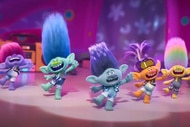
The Best Fantasy Movies Streaming on Peacock in April 2024
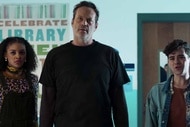
The Best Slasher Movies on Peacock for April 2024
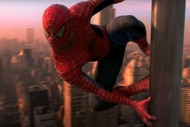
The Best Sci-Fi Movies on Peacock in April 2024
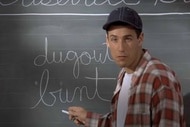
The Wild Cartoon World of Billy Madison

Bruce Almighty Teleprompter Scene Wasn't in Original Script
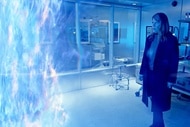
The 20 Best Sci-fi TV Shows on Peacock in April 2024

The Fast and the Furious: Remembering how the Fast Saga began
Recommended for you.

Linda Hamilton on Resident Alien Role: "I'm Not the Funny Girl, I'm the Straight Man"

The Classic Twilight Zone Episode That Inspired Jordan Peele's Us

Resident Alien's Alan Tudyk on Harry's New Love Interest, Edi Patterson's Blue Avian
25 Must-Watch Episodes of ‘Star Trek: Voyager’
“We're Starfleet officers. Weird is part of the job.”
Paramount+ recently renewed their roster of Star Trek shows, meaning fans have access to Star Trek all year-round. One of the best things about New Trek has been a renewed appreciation for Star Trek: Voyager . Be it the return of Kate Mulgrew as Hologram Janeway on Star Trek: Prodigy , Jeri Ryan reprising her role as Seven of Nine on Star Trek: Picard or Voyager’s enduring legacy nearly 1000 years in the future as seen on Star Trek: Discovery , the show has been inescapable. Former Voyager actors Garrett Wang and Robert Duncan McNeill have also revived interest in the show through their recaps on The Delta Flyers podcast.The fifth Star Trek show to debut on screens, Voyager was the first to have a female captain leading its crew and one of the more diverse casts in the roster when it debuted in 1995. Voyager faced plenty of criticism when it aired, but viewers’ newfound love for it is hardly misplaced. There is a lot to love and enjoy during the show’s seven-season run.If you’re wondering where to start with this underrated show or want to take a trip through the Delta Quadrant, let’s look at some of the best episodes to watch. RELATED: ' Star Trek: Voyager': The 7 Best Time Travel Episodes
Season 1, Episode 1: "Caretaker"
The pilot episode of Voyager sets the tone for an unpredictable journey through the Delta Quadrant. Voyager is tasked with retrieving a rebel Maquis ship when both ships are pulled more than 70,000 light years away by an entity known as the Caretaker. Neither crew emerges unscathed, and Captain Janeway must weigh impossible options to either return her crew home or save an entire civilization.
The episode gives viewers a glimpse of all the main characters and their unique personalities. We also meet the Kazon, the bane of Voyager’s life in early seasons. What “Caretaker” does well embodies the varied aspects of a Star Trek episode in one—there’s action, there are uncomfortable alliances and there’s solidarity in the face of adversity.
Season 1, Episode 14: "Faces"
“Faces” is a bold episode to include in the first season of a show. Voyager’s away team is captured by the Vidiians, a species that have advanced medical technology but are unable to cure themselves of the devastating disease, the Phage. The chief surgeon of the facility splits Voyager’s Chief Engineer B’Elanna Torres ( Roxann Dawson ) into two people—a Klingon and a human.
The episode examines B’Elanna’s conflict with her mixed heritage, the bullying she suffered because of it and her journey to accepting who she is. Through B’Elanna, we see an analogy for real-world discussions of identity, especially among minority communities. “Faces” will resonate with anyone who is struggling with their identity and how it’s viewed by others.
Season 1, Episode 15: "Jetrel"
Neelix ( Ethan Phillips ) was introduced as comic relief but “Jetrel” shows us a very different side to him. Dr. Ma'Bor Jetrel ( James Sloyan ) arrives at Voyager with dire news for Neelix but Neelix refuses to engage with him. Jetrel was the man behind the metreon cascade that decimated Neelix’s home world, killed his family and hundreds and thousands of other Talaxians.
The beauty of science-fiction is its ability to reflect real-world incidents through a genre-specific lens. “Jetrel” is obviously an analogy of the atomic bombings on Hiroshima and Nagasaki. The story channels the consequent suffering of the Japanese people through Neelix. The creators don’t attempt to redeem Jetrel but instead balance the varied emotions that both Jetrel and Neelix navigate when faced with each other.
Season 2, Episode 12: "Resistance"
Captain Janeway is separated from her away team and rescued by an alien named Caylem ( Joel Grey ). Caylem is convinced Janeway is his daughter, so Janeway tries to use his help to get back to her crew. Meanwhile, B’Elanna and Tuvok ( Tim Russ ) are captured and try to find a way out.
This seems like a straightforward episode—stranded on a planet, split up, captured by aliens, standard Star Trek stuff. But the episode allows B’Elanna and Tuvok to bond and get to know each other despite their differing personalities. However, it’s that heartbreaking dénouement that makes it a must-watch. Captain Janeway’s humanity and generosity come to the fore with a few lines of dialogue and will have you reaching for the tissues during the finale credits.
Season 2, Episode 21: "Deadlock"
Voyager spots Vidiian ships and hides in a nebula, only for the ship to start failing in mysterious ways. Lives are lost, and the ship is in shambles. Captain Janeway and her crew locate the source of their troubles. It’s another Voyager?
Duplicates, high stakes, technobabble, “Deadlock” feels like classic Star Trek. The creators capture the claustrophobia of a ship-based story and the sets perfectly capture the differing scenarios aboard the two Voyagers. The episode writers don’t pull any punches; sometimes space exploration can be deadly and Voyager has to face that fact. The conclusion is such a surprise—just when you think you know how the episode will end, the creators chuck in another twist.
Season 2, Episode 25: "Resolutions"
Unrequited love is a standard trope across pop culture, but “Resolutions” takes it to a whole new level. Captain Janeway and First Officer Commander Chakotay ( Robert Beltran ) transport to an isolated planet after they’re infected with a contagious disease. While Chakotay immediately takes it upon himself to make the planet their new home, Janeway still holds out hope that they’ll return to Voyager.
The episode is incredibly romantic despite lacking a concrete romance. Chakotay veritably declares his undying love for Janeway without saying the actual words, but just when Janeway begins to imagine her life without Voyager, Captain and Commander are miraculously saved. A happy ending has never been sadder. The thread of their almost-romance informs Janeway and Chakotay’s relationship throughout the show, but never overshadows it.
Season 3, Episode 3: "The Chute"
Tom Paris (McNeill) and Harry Kim (Wang) became fast friends in the first episode of Voyager and their friendship is one of the best in the franchise. So, what happens when the close buddies are wrongfully convicted and imprisoned in an alien prison?
“The Chute” is a tense episode that shines a spotlight on Tom and Harry during one of the worst ordeals they have together. It’s stressful watching Tom deteriorate and Harry reach the end of his tether. We’re on tenterhooks throughout worrying about how this friendship will survive this episode if it can at all! It all comes to a head in the final scenes and a simple line of dialogue that rights the world. This is heart-wrenching stuff that showcases the power and importance of friendship.
Season 3, Episode 8 & Episode 9: "Future’s End Parts I & II"
Time travel is an integral part of Star Trek, and one of Voyager ’s most memorable temporal stories is the two-parter “Future’s End”. In the episode, Voyager becomes trapped in the 20th century and can’t get back until they stop Henry Starling ( Ed Begley, Jr. ), a con man who has stolen future technology for his own gains.
This is an entertaining episode but also thought-provoking. Starling is a truly reprehensible villain compared to the other aliens that Voyager has met in the Delta Quadrant. The crew are also faced with an interesting conundrum—they’re back on Earth but in the wrong century, do they really want to return to their time when they’re 70-odd years away from home?
Season 3, Episode 16: "Blood Fever"
B’Elanna Torres is accidentally infected with the Vulcan Pon Farr which sets her hormones in overdrive. When she and Tom Paris are alone on an away mission, sparks fly but how real are these feelings?
“Blood Fever” is a sexy episode, with a lot of hot and heavy emotions bubbling to the surface. B’Elanna is aggressive with her desires, but the writers do a great job in making consent a priority. Tom was introduced as a cad on Voyager , and had his eye on B’Elanna, but he refuses to give in despite B’Elanna’s requests because she isn’t in a position to consent. The gender-flipped power play adds to the appeal of this episode. In the end, “Blood Fever” sets the stage for a romance but doesn’t ignite it, which is an important difference. Also, a new terrifying villain is introduced in the final moments. What’s not to love?
Season 3, Episode 23: "Distant Origin"
There are a few Star Trek episodes that have attempted to investigate the origins of humans, but in “Distant Origin” two scientists from an alien species called the Voth believe they originate from human beings. They capture Chakotay who reluctantly helps them.
The debate between traditional dogma and science is familiar to everybody and “Distant Origin” reflects the destructive impact of such rigidity through the Voth and the Doctrine. It’s maddening to watch the scientists lose their hard work and their future because of bureaucracy, which is what makes this episode so brilliant (and sadly, relatable). Another fantastic element is Chakotay’s characterization—his kindness and understanding are a balm during an otherwise tense episode. This is also a rare moment where aliens help Voyager altruistically.
Season 3, Episode 25: "Worst Case Scenario"
“Worst Case Scenario” begins with B’Elanna seemingly being encouraged by Chakotay to begin a mutiny, but just when things get interesting, the holo program stops. Suddenly everyone wants to play this program and learn the identity of the author.
While the author reveal is surprising, what comes after is gripping stuff. Tuvok, who had conceived the story as a training program, is convinced to complete the narrative, alongside a very eager Tom Paris. And that’s when things go very wrong. Tuvok and Tom make for an unlikely comedic duo—Tuvok, dour and logical as ever, Tom, a bit too flippant considering the danger they find themselves in.
There are twists and turns that one would never expect, and laughs aplenty, as the entire ship finds itself facing a talented adversary.
Season 4, Episode 8 & Episode 9: "Year of Hell Parts I & II"
Another time-focused two-parter, “Year of Hell” puts the Voyager crew through the grind, and they shine despite it all. The ship is caught in a series of temporal incursions created by Krenim scientist Annorax ( Kurtwood Smith ) and each one devastates the ship more and more. Unable to get out, the crew do everything they can to survive.
“Year of Hell” is a harrowing episode, but the best part of it are the character interactions and dynamics. Tuvok and Seven’s relationship, Chakotay falling for Annorax’s big ideas, Neelix’s promotion, the politics aboard the Krenim ship, Captain Janeway’s valiant sacrifice—they all come together to create a moving and immersive experience. The Voyager crew have never been closer than in this two-parter. The dénouement feels like a well-earned relief.
Season 4, Episode 14: "Message in a Bottle"
If you need a laugh, “Message in a Bottle” is the perfect bottle episode. The Doctor ( Robert Picardo ) is transmitted as a holographic message to the Alpha Quadrant. The only problem? The ship he arrives at has been overtaken by Romulans. The Doctor then has to partner with the captured ship’s emergency medical hologram, the Mark 2 ( Andy Dick ), to survive and save the ship.
If you thought the Doctor had a bad attitude, the Mark 2 somehow trumps even him. The banter between the two EMHs powers this entire episode and the comedic timing of Picardo and Dick is stellar. What should be a stressful situation becomes a comedy of errors because we’re following the exploits of two doctors—EMHs—not trained Starfleet officers.
Season 5, Episode 6: "Timeless"
One of the most heartbreaking episodes on Voyager is another time travel story. This time, Harry and Chakotay are on a mission to save their friends who died in the Delta Quadrant fifteen years ago.
From the opening teaser reveal to the final scene, “Timeless” tugs at the bond that the Voyager crew has formed with one another, and with the viewer. Director LeVar Burton perfectly juxtaposes the joyous celebrations of the past with the eventual doom in the ‘present’. Seeing Harry transform from hopeful and optimistic to jaded and fatalistic adds another layer of shock to the proceedings. “Timeless” will make you want to bawl your eyes out. It doesn’t matter how many times you watch this episode; you will be overcome with emotion by the end.
Season 5, Episode 10: "Counterpoint"
Star Trek has rarely shied away from reflecting the atrocities committed by humanity and “Counterpoint” is another great entry in the franchise. Voyager is secretly housing telepathic species who are seeking refuge through an expanse of occupied space. The ship is constantly inspected by the smarmy Devore Imperium officer, Kashyk ( Mark Harelik ). And then one day it’s Kashyk who’s asking for refuge.
There are so many layers and subtleties that make this episode a memorable and heartbreaking one. The obvious references to Nazi Germany make it a powerful watch, but the interplay between Captain Janeway and Kashyk is riveting. This is a spotlight episode for the captain, and she is written as compassionate and intelligent. The writers cleverly subvert our expectations of the conclusion, and you will be left feeling as crushed as Janeway by the end of it.
Season 5, Episode 12: "Bride of Chaotica"
Another Captain Janeway episode, but this one is so different. Tom and Harry’s The Adventures of Captain Proton holodeck program is one of the more memorable holodeck programs in the franchise. In “Bride of Chaotica”, photonic lifeforms mistakenly believe the program is real and begin fighting the evil Doctor Chaotica ( Martin Rayner ). The battle affects the ship and soon Janeway is on the holodeck assuming the new role of Queen Arachnia.
This episode fully embraces the cheesy, hammy style of classic science-fiction. Tuning in to “Bridge of Chaotica” is like switching off your brain and enjoying 45 minutes of bombastic performances, bulky props and a lot of fun. This is exactly the kind of silliness that a holodeck-based episode should embrace.
Season 5, Episode 21: "Someone to Watch Over Me"
It can be very icky when an older gentleman falls for a much younger woman, but “Someone to Watch Over Me” still makes the interaction between the Doctor and Seven of Nine a touching one. The Doctor takes it upon himself to help Seven learn some social skills, especially the art of dating. The two of them bond over songs and banter, and it’s not long before the Doctor begins falling for his student.
The episode doesn’t go any further with their relationship, and that’s the beauty of it. Once Seven decides to put dating on hold, the Doctor realizes the door to explore other aspects of their relationship is closed. Voyager is made for lovers of unrequited love, and you will be all choked up as Picardo sings a heartbreaking version of “Someone to Watch Over Me” as the episode closes.
Season 6, Episode 4: "Tinker Tenor Doctor Spy"
The Doctor is a man of many talents, or so it seems in “Tinker Tenor Doctor Spy”. The story sees the Doctor alter his program so that he can daydream, only for an unsuspecting alien scientist named Phlox ( Jay M. Leggett ) to tap into the feed. Soon, Phlox’s mistake and the Doctor’s tampering put Voyager at risk. And only the Emergency Command Hologram can save them.
There’s a lot to be said about the innovative ways the Voyager writers allowed Picardo to flex every muscle he could. This laugh-out-loud episode is crisply paced and comedic gold. The Doctor’s love for daydreaming is one of his most human aspects. But it’s the writers’ ability to imbue the unknown character Phlox with so much personality and high stakes that elevates this episode.
Season 6, Episode 6: "Riddles"
Frenemies Tuvok and Neelix are returning on the Delta Flyer when Tuvok is attacked and loses his memory. The crew is desperate to get their chief tactical officer back and Neelix takes it upon himself to help Tuvok heal. But along the way, both characters learn that there’s more to each other’s personalities and themselves.
Star Trek is all about friendships and “Riddles” captures the importance of that. Tuvok always acts like he barely tolerates Neelix, but Neelix never seems to take the hint—this episode explores why. It’s so sweet and the relationship between Tuvok and Neelix is affectionate and touching. “Riddles” was actor Roxann Dawson’s first directorial effort on the show, and she does a great job evoking myriad emotions from the central cast.
Season 6, Episode 10: "Pathfinder"
“Pathfinder” is a rare episode that doesn’t center Voyager. Set on Earth, Lieutenant Reginald Barclay ( Dwight Schultz ) is part of the Pathfinder project to help the ship find her way home. Except, Barclay is a little too obsessed with the project and his holodeck program… of the Voyager crew. When the problem reaches a peak, Barclay’s friend, Enterprise Counselor Deanna Troi ( Marina Sirtis ) tries to help him work through it.
Brilliantly paced with obvious roots in Star Trek: The Next Generation , “Pathfinder” feels very meta. Barclay is every Star Trek fan come to life—desperate to be part of a story he dearly loves. Schultz and Sirtis step into the shoes of their TNG characters with ease, and the workplace setting also adds to the novelty of the episode.

Relativity (episode)
- View history
Seven of Nine is recruited by a starship from the 29th century to save Voyager from being destroyed in the past.
- 1.2 Act One
- 1.3 Act Two
- 1.4 Act Three
- 1.5 Act Four
- 1.6 Act Five
- 2 Memorable quotes
- 3.1 Story and script
- 3.2 Cast and characters
- 3.3 Production
- 3.4 Visual effects
- 3.5 Continuity
- 3.6 Reception
- 3.7 Video and DVD releases
- 4.1 Starring
- 4.2 Also starring
- 4.3 Guest stars
- 4.4 Co-star
- 4.5 Uncredited co-stars
- 4.6 Stand-ins
- 4.7.1 Spacecraft references
- 4.7.2 Dedication plaque references
- 4.8 See also
- 4.9 External links
Summary [ ]
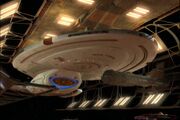
Voyager in drydock
In 2371 , Captain Janeway beams aboard the starship USS Voyager during the final phases of the Voyager 's construction at Utopia Planitia . Admiral Patterson , who had been her calculus instructor at Starfleet Academy , is there to greet her with a pop quiz . After Janeway answers all of his questions correctly, Patterson shows her around her new ship. When they reach the bridge , Janeway starts to comment on how it is bigger than she expected. She sits in her chair briefly, then is shown her ready room . There, Janeway brings up her mission, specifically, Tuvok and her desire to bring in Thomas Paris . Back to the bridge, she begins proposing changes to Voyager already and, as she and the admiral start to get into a conversation, an ensign walks away from the helm . The ensign is a completely Human-looking Seven of Nine , avoiding eye contact.
Act One [ ]
Seven of Nine scans the bridge and the observation lounge with a small, sleek tricorder . There, Janeway and Patterson come in, and she quickly hides her tricorder. After a brief chat, they leave, and she continues scanning, then leaves for engineering . There, she encounters Lieutenant Joe Carey , who, being friendly, questions her to get to know her. Her cover story has her not assigned to the ship, but rather Utopia Planitia. She then enters a Jefferies tube and locks it. She starts scanning again. She contacts someone, telling them that she localized the weapon 's source. Opening a hatch inside the tube, she sees a strange device inside it. The people she is in contact with tell her to begin a procedure. She attempts to remove it, but cannot because the device is out of phase ; she is in the wrong timeline, but her contact says it's still good they know where it is.
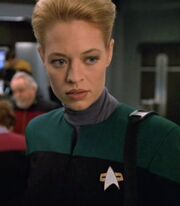
Seven of Nine on Voyager 's bridge
Meanwhile, Janeway and Patterson overhear Carey finding a malfunction in an EPS relay . Wanting to get her hands dirty, Janeway goes to the Jefferies tube, only to find it locked from the inside. Patterson and Janeway go to another deck to access the tube. Seven of Nine detects them and discontinues her procedure, waiting for beam-out. Aboard another, apparently very advanced starship, the Captain says to pull her out, even when they have trouble locking on to her, saying that if Janeway and Patterson find her, then it will contaminate the timeline . When Janeway and Patterson reach the tube, Janeway only finds a strange chroniton flux of .003 that vanishes.
On the advanced ship, Seven approaches the temporal threshold and materializes onto their ship successfully, however, she falls unconscious. One of the officers goes to check on her, but, as he had warned his captain, she is dead.
Act Two [ ]
Since Seven is dead, the Captain orders to recruit her again. The XO , Lieutenant Ducane , orders a new time index in the Delta Quadrant , target: USS Voyager .
On a seemingly normal day in 2375 , The Doctor is examining Seven of Nine for symptoms of blurry vision and dizziness , which she believes are symptoms of Albright-Salzman syndrome . The Doctor concludes that she in fact has a mild case of sensory aphasia , which he clears up. The Doctor then returns to sickbay , where he begins to find many cases of space sickness , including Janeway.
Meanwhile, Paris is walking through the corridors doing a ping pong exercise. He invites Seven to be on his team for a ping pong tournament because his other team member had come down with space sickness. She accepts and Paris continues his exercises. The tournament takes place in the mess hall against Harry Kim and B'Elanna Torres , with Neelix keeping score . Shockingly, just as Paris spikes the ping pong ball, it stops in the middle of the table in mid-air. Seven scans the table and detects a temporal anomaly . Seconds later, the ball shoots back towards Kim and Torres. Neelix jokingly still records it as a point.
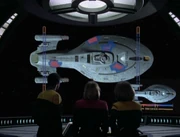
Tuvok, the captain and B'Elanna Torres observing the temporal anomalies on the ship
Tuvok, Janeway, and Seven then find that temporal anomalies are occurring all over the ship and will soon tear the ship apart, so Seven and Torres start looking for the source of the anomalies, while the Captain tells The Doctor about them. He suspected an anomaly, with the large number of cases of space sickness he's seen. Neelix then calls The Doctor to the mess hall because Ensign Mannus is violently ill. Once there, oddly, Neelix greets him as if nothing was wrong. He asks Neelix where the medical emergency is. Neelix says that everything was fine there. At that moment, Mannus falls unconscious. The Doctor diagnoses him with space sickness then revives him. He then starts to put it all together. He checks the time in the mess hall and in sickbay. Sickbay is several minutes ahead of the mess hall. Neelix had not made his call to sickbay yet.
Chakotay reports to Janeway, who just had three day old replicated coffee . As it is apparent, the distortions are interfering with food replicators . Janeway then decides to input security measures. As Chakotay explains that turbolifts are malfunctioning and everyone is forced to use the Jefferies tubes , a temporal fracture accelerates his conversation by a few seconds.
Meanwhile, Torres and Seven found the source of the anomalies. It was coming from a device in the Jefferies tube that only Seven can see with her ocular implant . They tell the Captain, who is ready to initialize a set of force fields to counteract the anomalies. The plan fails and the hull starts to demolecularize . Just then, two men from the unknown ship beam in, giving off a similar chroniton flux from five years ago, spacedock. The captain orders all hands to abandon ship. As Seven moves to an escape pod , she sees the two men. She tells them to identify themselves. They ignore her and place a device on her which beams the three of them away. Seconds later, Voyager is split apart and explodes with almost everyone on it.
Act Three [ ]
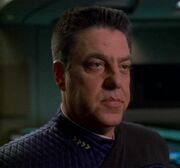
Captain Braxton telling Seven to avoid Kathryn Janeway
Captain Braxton welcomes Seven to the Federation timeship USS Relativity . They explain to Seven that Voyager has just exploded due to a saboteur putting a force-3 temporal disruptor on the ship. They suggest to Seven that the saboteur transported onto Voyager while Voyager 's shields were down in an attack by the Kazon . Seven agrees to help them prevent Voyager 's destruction. Ducane begins by testing her on all things about time, such as the Pogo paradox , when the Borg tried to prevent the Federation from ever existing , incidentally creating it. Then, she goes to a holodeck to view the device in its location on Voyager with Braxton. Braxton unexpectedly orders her to avoid contact with Janeway if at all possible, for she has made more temporal violations than anyone in history and sticks her nose where it doesn't belong: hence he calls it the Janeway Factor , due to which he had to fix up three major temporal incursions . He also mentions the timeframe he was stuck in for thirty years . Ducane finally uses a technology to hide her Borg implants and she's ready.
In 2372 , Voyager is under attack by the Kazon when Seven of Nine beams aboard Voyager . She starts scanning for the weapon immediately.
Act Four [ ]
The crew is focused on the attack when Harry Kim detects a 0.003 chroniton flux. They rule out the Kazon's weapons as the cause, and Janeway recognizes the reading from Voyager in drydock (as she did over 2 years later). She studies it as the battle subsides, the Kazon lead ship having been disabled, and the ship escapes. Janeway remembers the last time she saw the chroniton reading and places a force field around the area. Like her 2375 counterpart, Janeway and Tuvok both go to where Seven is; however, this time the force fields isolate Seven from her 29th century colleagues. Unable to receive instructions, Seven is trapped in the corridor and Janeway finds her. On the timeship, Ducane continues to try to pull her out, but the force field continues to interfere with the transport and communications.
Janeway demands she explain who she is, and Seven initially tries to avoid telling Janeway the truth, due to the Temporal Prime Directive , as Braxton listens in. Unfortunately, Tuvok detects Seven's hidden Borg implants so Janeway orders a search for any nearby vessels and is even more concerned. Seven insists there are none and, disregarding the Temporal Prime Directive, gives up and tells Janeway the truth. Seven convinces Janeway to free her to help prevent the destruction of Voyager in 3 years, 6 months and 2 days. In the 29th century aboard the Relativity , a crew member utters the Latin phrase tempus fugit , which literally translates as time flies .
Seven and Janeway quickly go to the Jefferies tube where the weapon should be. Janeway, Tuvok, and Seven enter and find a man trying to place the disruptor in the tube. It turns out to be an older Captain Braxton.
Act Five [ ]
The older Braxton quickly arms his device and threatens to activate it unless they lower their phasers. They do so, and then soon the younger Braxton calls in and is extremely surprised to hear who it is. The saboteur Braxton explains that this will complete "our" mission. He had undergone a temporal psychosis , having lost his rank which he blames on Voyager . He tells his "younger" self that once Voyager is obliterated, he will heal. The Braxton on the Relativity is determined to bring his older self into custody, telling Ducane to beam him aboard, but the older Braxton had activated a dispersal node to avoid beaming. Ducane then takes it upon himself to relieve his captain, placing him under arrest for crimes "he is going to commit."
Just as Seven of Nine is about to capture the older Braxton, he beams off Voyager . Seven then transports to where Braxton beamed to: back to 2371. Back during Janeway's first tour of Voyager with Admiral Patterson, they walk down a corridor as Seven and Braxton come running through. Seven shoots at Braxton, but misses. Seven starts to suffer from temporal psychosis and starts to drift out of consciousness. Due to Janeway's quick order to bring up force fields, Braxton is contained, but he then beams himself to 2375. Seven calls to be transported there.
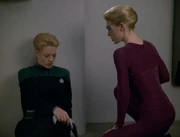
Seven of Nine encounters her temporal counterpart
In the mess hall, the ping pong tournament is occurring. Braxton suddenly runs through and Seven, almost unconscious, walks in and disables Braxton's tricorder, trapping him in 2375. He runs, but she then falls to the ground. The Seven of Nine in this timeline walks up to her counterpart, asking her to explain herself. Seven's counterpart tells the other Seven to stop Braxton because their future depends on it. After Relativity beams the incapacitated Seven away, the other Seven captures Braxton. When Janeway arrives, she realizes that she remembers him from 2372. Relativity beams Braxton away. They then beam Janeway to their ship.
Ducane starts to explain to Janeway all that had happened, quickly giving her a headache . He explained that there is a Braxton in their brig and a Braxton on their bridge. They ask Janeway to go back to 2372 to completely fix the timeline. Seven's attempts to remove the device have introduced several noticeable temporal incursions . She instigated a phaser fight at Utopia Planitia, interacted with Janeway's three years younger self and spoke to her younger self during a ping pong tournament in front of 15 crew members. By capturing Braxton before the device is planted these changes will be removed. Seven cannot do it because she might damage herself. Janeway is confused, especially with the second Seven. Ducane assures her that by the end of the day, there will be only one Seven. The Braxtons will soon be reintegrated in time for the trial. The Braxton on the bridge tells Janeway where he will be in that timeline and Janeway is transported to 2372.
Janeway is beamed aboard during the Kazon attack on Voyager . She encountered Torres en route, telling her to do what she think is right in Engineering. When she nears the corridor where Braxton will beam in, she hides from her three years younger self. Almost immediately, she finds Braxton beaming aboard. He stumbles over a wounded crewman. At that moment, Janeway walks over to him and captures him.
Back on Relativity , Ducane commends Janeway for capturing the last Braxton and making a small incursion of 0.0036. He then is ready to send Seven of Nine and Janeway back to 2375's Voyager , reintegrated with their past selves. He strictly reminds them to remember the Temporal Prime Directive: discuss your experiences with no one. Yet he tells her one thing: Braxton was right that Voyager appears on the Relativity 's sensors too often and they should avoid time travel. They then beam back to the 2375 Voyager .
Memorable quotes [ ]
" Tempus fugit . "
" Long time no see. "
" So, in a way the Federation owes its existence to the Borg. " " You're welcome. "
" What is the threshold of the H 2 molecule? " " 14.7 electron volts " " Third brightest star in Orion? " " Viewed from where? " " Earth. " " Gamma Orionis or Bellatrix if you prefer the original Arabic name. " " Not bad. Now give me a hug Katie, that's an order. "
" See you in the 24th century. " " I look forward to it. Or should I say backward? " " Don't get started! "
" Thanks to you, we've learned that the temporal disruptor was, and will be concealed here… I gave up trying to keep my tenses straight years ago. "
" … and I ended up stranded in the late 20th century. Have you ever been to that time frame? " " No. " " Well, I don't recommend it. After three decades with those post-industrial barbarians, I had to go through extensive rehabilitation before I could return to duty. Avoid contact with Janeway. That's an order. "
" We have a saying in our line of work: There's no time like the past. "
" Janeway! " " Have we met? " " Too many times! But you wouldn't remember, they haven't occurred yet. "
" Seven of Nine to Seven of Nine, what's your status? "
" Wait a minute let me get this straight, I'm going to go back in time to stop Braxton, but you already have him? " " And there's a third one in our brig; I arrested him earlier today. But don't worry, they'll all be reintegrated in time for the trial. " " And Seven? " " Oh I assure you when this is over there will be only one Seven of Nine " " Alright, let's just get started before my headache gets any worse. "
" Needless to say we need to clean up the timeline. Someone must go back to the beginning and prevent the chain of events from ever occurring in the first place. " " I can't make another jump without damaging myself. " " … I get the feeling I'm about to be drafted. "
" Is this a part of the tour? "
" Oh captain, Braxton was right about one thing: Voyager shows up on our sensors far too often. Try to avoid time travel."
" I'm detecting bio-mechanical implants. They have a Borg signature. " " Janeway to the bridge, scan the vicinity for Borg ships. " " Did you say Borg? " " Do it! "
" Next time your Human physiology fails you, don't consult the database; just call me. " " You are the database. " " With two legs and a splendid bedside manner. "
" I'm sorry, sir. I'm taking command of this vessel, and I'm relieving you of duty for crimes you're going to commit. "
Background information [ ]
Story and script [ ].
- This was the last of five Star Trek: Voyager episodes that Nick Sagan , story editor for the series' fifth season , was involved in writing. He previously worked on " In the Flesh ", " Gravity ", " Course: Oblivion ", and " Juggernaut ". In his capacity as story writer and teleplay co-writer here, Sagan found this to be an enjoyable episode to write. He later reminisced, " I think that might have been the easiest one I worked on, because the goal is simply to have fun. With the others I felt a lot of different loyalties to character this, character that. For some reason that one came together very quickly, and it was such a joy to write because we were just trying to please ourselves. " [1]
- Executive Producer Brannon Braga did a lot of uncredited rewriting on the episode. ( Cinefantastique , Vol. 31, No. 11, p. 55)
- One aspect of this installment that was changed was its depiction of the Utopia Planitia Fleet Yards; the episode's script originally called for only a simple shot of a lone Voyager in drydock at Utopia Planitia. Adam "Mojo" Lebowitz noted, " One ship, one drydock, and that was it. " ( Star Trek: The Magazine Volume 2, Issue 9 , p. 102)
- Paris' winning strike during the ping pong match is an illegal move and would have resulted in a point for Kim/B'Elanna - if they played by official rules.
Cast and characters [ ]
- Not having been a science fiction fan prior to her work on Star Trek: Voyager , Seven of Nine actress Jeri Ryan found this time travel episode's script difficult to follow. " It was a challenge just keeping the time frames straight, " she admitted. ( Cinefantastique , Vol. 31, No. 11, p. 28)
- Jeri Ryan also found it humorously coincidental that, in this outing, her character wears the disguise of a Starfleet uniform, a fact the actress described as "actually very funny." She continued, " I had just done an online chat three or four days before this script came up. As they always do, one of the fans had asked me when we were going to see Seven in a Starfleet uniform, and I said, 'Well, never, because she's not Starfleet, of course.' Then bam, I get a call from wardrobe two days later saying, 'We need you to come in for a fitting because you are in a Starfleet uniform for the next episode.' " ( Cinefantastique , Vol. 31, No. 11, pp. 28-29)
- Although Captain Braxton appeared in Star Trek: Voyager twice before, he is played by a different actor in this episode, with Bruce McGill replacing Allan G. Royal .
Production [ ]
- The 29th century phaser that Seven of Nine uses against Braxton is of the same type seen in possession of Henry Starling 's assistant Dunbar in the third season episode " Future's End " during the phaser fight outside the Griffith Observatory in Los Angeles in 1996 .
- The thrombic modulator is seen again in this episode, having first been seen in " Message in a Bottle " when The Doctor didn't know what it was.
- Another prop reused in this episode is the triangular device that Lieutenant Ducane places on Seven of Nine 's arm before transporting her to the USS Relativity . It was used in " Tattoo " as a universal translator between one of the Sky Spirits and Chakotay .
- Even though some minor cosmetic changes were made to the Voyager sets for the fourth season (for example, the trim on the briefing room table as well as the ready room desk was changed from a gray to green), the scenes from this episode that take place prior to " Caretaker " show the newer set colors.
- According to the unauthorized reference book Delta Quadrant (pp. 312 & 314), the bridge of the Relativity was a redress of the USS Enterprise -E bridge, with interior design elements from the Enterprise -E and Voyager .
Visual effects [ ]
- The reasoning why the Utopia Planitia Fleet Yards was depicted as more extensive than the script suggested was that the visual effects artists from Foundation Imaging were extremely excited about visualizing the elaborate shots that open this episode. " As fans who were working on the show, we couldn't bear to be this close to seeing the shipyards and not go all the way, " reflected Adam Lebowitz. " So, in our own time, we created the entire shipyard and took rough drafts of the shots we had in mind to VFX supervisor Ron Moore and producer Peter Lauritson . Luckily, they were very receptive. It may have only amounted to two shots in the final episode, but they were an absolute labor of love for all of us. The half-constructed ships looked great (thanks to the hard work of Koji Kuramura ), and the image of Mars you see in the final sequence is made from a satellite photo of the real Utopia Planitia , courtesy of the folks at NASA . In fact, the whole time we were working on the episode, we thought it was a shame that the people at home would only see this stuff on blurry TV screens, and not in the high-resolution glory we had created them in. " ( Star Trek: The Magazine Volume 2, Issue 9 , p. 102) Robert Bonchune and Lee Stringer were others at Foundation Imaging who donated personal time to realize the sequence. ( citation needed • edit )
- The battle scenes between Voyager and the Kazon were stock footage of combat from earlier episodes, in the order of " Alliances ", " Caretaker ", and " Basics, Part I ".
Continuity [ ]
- This episode features the return of not only Captain Braxton , whose previous appearances were in the two-parter " Future's End " and " Future's End, Part II ", but also Lieutenant Joe Carey , who was last seen in Season 1 's " State of Flux ". However, Carey's scenes here take place before Voyager is lost in the Delta Quadrant. He returns in VOY : " Fury ", but his scenes in that episode also take place in the past. He is not seen again in the present (namely, 2378 ) until VOY : " Friendship One ", in which he is killed.
- Braxton mentions that Janeway and Voyager are involved in three major "temporal events". The first ("30 years trapped in the 20th century") is clearly a reference to " Future's End " while the second ("temporal inversion in the Takara sector") is a more subtle reference to " Timeless ". The third was never described. However, it could be the events of " Year of Hell " and " Year of Hell, Part II " or the series finale " Endgame ".
- Seven of Nine travels back in time to Voyager during a Kazon attack, though this specific event does not seem to be from a previous episode featuring the Kazon. Ducane states the stardate target for the temporal transport as 49123.5621. This would place the events as occurring between the second-season episodes " Parturition " and " Cold Fire ". The conflict with the Kazon was taking place during that time.
- Braxton claims to remember being stranded in the 20th century in this episode, despite having claimed to Janeway at the conclusion of " Future's End " that he "never experienced that timeline."
- In scenes set at the Utopia Planitia Fleet Yards , this episode makes several references to the events of " Caretaker ". Notably, Janeway and Admiral Patterson discuss the whereabouts of Tuvok (undercover on Chakotay's Maquis ship), enlisting Paris, and going to the Badlands .
- In this episode Janeway tells Admiral Patterson that she wants to enlist Tom Paris' help because his superior piloting skills can help them get through the Badlands , however in " Caretaker " Janeway recruits Paris to lead her to hidden Maquis bases, with her making clear during that episode that she did not expect him to pilot.
- This episode features the eighth of nine times that Kathryn Janeway 's death is depicted over the course of the series. Previous episodes that depict this include " Time and Again ", " Deadlock ", " Before and After ", " Worst Case Scenario ", " Year of Hell, Part II ", " Timeless ", and " Course: Oblivion ". On this occasion, the version of Janeway that succumbs to death is that of an alternate timeline that ultimately doesn't come to pass, and the cause of death is Voyager 's destruction as a result of the temporal distortions.
- This episode features the fifth and final time that the destruction of Voyager is depicted on the series, previous occasions being " Deadlock ", " Year of Hell, Part II ", " Timeless ", and " Course: Oblivion ". On this occasion, an alternate timeline version of Voyager is destroyed by temporal distortions.
- According to the stardates, the 2375 portions of this episode take place at about the same time as DS9 : " The Dogs of War ", which was originally broadcast two weeks later.
- This is the first episode to feature the actual Utopia Planitia Fleet Yards . The fleet yards were seen previously in a picture in TNG : " Parallels " and as a holographic simulation in TNG : " Booby Trap ".
- The 29th century temporal transporter is noted to leave behind a chroniton flux. Previously, DS9 : " Past Tense, Part I " had several people being accidentally transported through time due to interference from chronitons.
- The events of Star Trek: First Contact are used as an example for the Pogo paradox .
- In TNG : " Timescape " there are also localized time discrepancies as time running faster or slower in specific locations from inside a room to a vast region in space.
- Captain Braxton wears a blue uniform indicating that at some point in the future the command division will switch to blue uniforms.
- Admiral Patterson is shown activating the Doctor's program during Captain Janeway's inspection tour in dry dock, however previous episodes (most notably " Projections ") firmly established the Doctor's first activation didn't occur until after Voyager arrived in the Delta Quadrant .
- Ducane states that the multiple surviving versions of Braxton would be "reintegrated". What this entails is not specified, but given the existence of the temporal transporter, it could be a version of the technique in TOS : " Tomorrow is Yesterday " where Spock used a conventional 23rd century transporter to combine two versions of John Christopher together, though in that case Spock was able to suppress the knowledge John Christopher had gained about the future.
Reception [ ]
- Ultimately, Brannon Braga was extremely pleased with this installment. " 'Relativity' is a time travel romp, " he declared. " It's an incredibly fast-paced, mind-bending, fun, time travel story. [The identity of the bomber] will be a real shocker. " ( Cinefantastique , Vol. 31, No. 11, p. 55)
- Nick Sagan was also satisfied with this outing, likewise finding it to be fun. He stated, " I don't think it's an episode that needs to be studied, per se, or ruminated upon, you just go with it like a rollercoaster ride. " [2]
- The book Star Trek 101 (p. 177), by Terry J. Erdmann and Paula M. Block , lists this episode as one of the "Ten Essential Episodes" from Star Trek: Voyager .
- Among the costumes and props seen in this episode which were sold off on the It's A Wrap! sale and auction on eBay was Jay Karnes ' uniform. [3]
Video and DVD releases [ ]
- UK VHS release (two-episode tapes, CIC Video ): Volume 5.12, 22 November 1999
- As part of the VOY Season 5 DVD collection
Links and references [ ]
Starring [ ].
- Kate Mulgrew as Captain Kathryn Janeway
Also starring [ ]
- Robert Beltran as Chakotay
- Roxann Dawson as B'Elanna Torres
- Robert Duncan McNeill as Tom Paris
- Ethan Phillips as Neelix
- Robert Picardo as The Doctor
- Tim Russ as Tuvok
- Jeri Ryan as Seven of Nine
- Garrett Wang as Harry Kim
Guest stars [ ]
- Bruce McGill as Braxton
- Dakin Matthews as Patterson
- Jay Karnes as Ducane
Co-star [ ]
- Josh Clark as Lieutenant Carey
Uncredited co-stars [ ]
- David Keith Anderson as Ashmore
- Michelle Artigas as Voyager operations officer
- John Austin as Voyager operations officer
- Elizabeth Carlisle as Voyager command officer
- Marvin De Baca as Patrick Gibson
- Anthony DeLongis as Culluh (picture)
- Brian Donofrio as Voyager sciences officer
- Cheryl Eckelberry as Relativity bridge officer
- Andrew English as Voyager operations officer
- Tarik Ergin as Ayala
- Keith Estelle as Voyager operations officer
- Sylvester Foster as Timothy Lang
- Tom Gianelli as Voyager operations ensign
- Caroline Gibson as Voyager operations officer
- Matthew Cannon Hanson as alien Relativity helmsman
- Linda Harcharic as Voyager command officer
- Peter Harmyk as Thompson
- Sunny Hawks as Voyager sciences officer
- Kerry Hoyt as Fitzpatrick
- David Kang as Relativity bridge officer
- Pete Leinbach as Voyager command officer
- Arthur Murray as Voyager command officer
- Erin Price as Renlay Sharr
- Heather Rattray as Voyager operations officer
- Jerome Robertson as Voyager sciences officer
- Linda Samsyoa as Relativity bridge officer
- Richard Sarstedt as William McKenzie
- Josh Sinyard as Voyager sciences officer
- Linnea Soohoo as Voyager sciences officer
- Pablo Soriano as Voyager operations ensign
- Steve Stella as Voyager command officer
- Warren Tabata as Voyager operations officer
- Michele Triviso as Voyager command officer
- Joan Valentine as Voyager operations officer
- Stuart Wong as Voyager command officer
- Unknown actor as Mannus
Stand-ins [ ]
- Sue Henley – stand-in for Kate Mulgrew
- Susan Lewis – stand-in for Roxann Dawson
- Nicole McAuley – photo double for Jeri Ryan
- Brita Nowak – stand-in for Jeri Ryan
- Lemuel Perry – stand-in for Tim Russ and utility stand-in
- J.R. Quinonez – stand-in for Robert Picardo , Josh Clark , and Bruce McGill
- Keith Rayve – stand-in for Robert Duncan McNeill , Dakin Matthews , and Jay Karnes
- Joey Sakata – stand-in for Ethan Phillips
- Richard Sarstedt – stand-in for Robert Beltran
- Pablo Soriano – stand-in for Bruce McGill
- Stuart Wong – stand-in for Garrett Wang and Bruce McGill
References [ ]
20th century ; abandon ship ; access point ; Albright-Salzman syndrome ; barbarian ; battle stations ; Bellatrix ; bedside manner ; biomechanical implant ; bionetic implant ; bioreading ; Borg ; Borg drone ; Borg signature ; brig ; cerebral cortex ; Chapman, William ; chroniton ; chronometer ; chronometric systems status ; chroniton flux ; class 9 warp drive ; Cochrane, Zefram ; coffee ; coincidence ; containment generator ; Dali paradox ; damage ; damage control team ; deck ; diagnosis ; disaster ; dispersal node ; dizziness ; Delta Quadrant ; drafting ; drydock ; Earth ; electronvolt ; emergency power ; emergency override EPS manifold ; EPS relay ; evasive maneuvers ; Federation ; fractal calculus ; hand-eye coordination ; hatch ; headache ; history ; holomatrix ; hull breach ; hydrogen ; inaprovaline ; incursion factor ; inertial damper ; inferior species ; interference ; internal chronometer ; intruder alert ; Jameson, Anna ; Janeway Factor ; Jefferies tube ; Kazon ; logic ; M class ; memory engram ; meter ; metric ton ; Milky Way Galaxy ; milligram ; mission ; modulation ; navigational sensor ; neural damage ; neurological condition ; nightmare ; occluder ; ocular implant ; Orion ; Paris, Owen ; pedantic ; ping pong ; Pogo paradox ; pop quiz ; post-industrial ; rehabilitation ; relieved of duty ; retirement ; sabotage ; saboteur ; sawdust ; score ; second opinion ; self-diagnosis ; sensory aphasia ; server ; service number ; signal ; small talk ; space sickness ; space-time fracture ; spatial charge ; stardate ; Starfleet Medical Database ; suspect ; Takara sector ; TCARS ; temporal disruptor ; temporal distortion ; temporal incursion ; temporal inversion ; temporal field emitter ; temporal paradox ; Temporal Prime Directive ; temporal psychosis ; temporal integration ; temporal transport ; temporal transport beacon ; temporal threshold ; tempus fugit ; tense ; time frame ; time jump ; time travel timeline ; time paradox ; trial ; tricorder ; tricyclic input manifold ; torpedo ; turbulence ; Utopia Planitia ; Utopia Planitia Fleet Yards ; Val Jean ; visual acuity index ; wrist
Spacecraft references [ ]
Akira -class ( unnamed ); cargo management unit ( unnamed ); Enterprise , USS ; Excelsior -class ; Fredrickson , USS ; Galaxy -class ( unnamed ); Intrepid -class ; Kazon raider ( unnamed ); Predator -class ( unnamed ); Relativity , USS ; Saber -class ( unnamed ); Steamrunner -class ( unnamed ); timeship ; Wells -class
Dedication plaque references [ ]
BAS ; Beltran, R. ; Berman, R. ; Braga, B. ; Burton, L. ; Eastman, A. ; Howard, M. ; Lauritson, P. ; Mulgrew, K. ; McNeill, R.D. : MD ; NCV ; NCV (degree); NTSC ; OCL ; PhD ; Phillips, E. : Picardo, R. ; Rauch, E.M. ; RET ; Russ, T. ; Ryan, J. ; Taylor, J. ; Taylor, M. ; Temporal Integrity Commission ; University of Copernicus ; Wang, G.
See also [ ]
- List of time travel episodes
External links [ ]
- "Relativity" at StarTrek.com
- " Relativity " at Memory Beta , the wiki for licensed Star Trek works
- " Relativity " at Wikipedia
Screen Rant
5 star trek time loop episodes, ranked.
Star Trek loves a good time loop and here are 5 of the best. Star Trek loves a good time loop and here are 5 of the best.
- Time loop stories are a classic science fiction premise Star Trek excels at.
- Star Trek: Enterprise and Voyager had excellent time loop episodes, but The Next Generation's "Cause and Effect" is the best.
- Star Trek: Discovery had two time loop episodes, "Magic to Make the Sanest Man Go Mad" and "Face the Strange".
Time loop stories are a classic science fiction premise, and Star Trek has dipped into that well several times. Although Star Trek: The Original Series never did a traditional time loop episode, plenty of Captain James T. Kirk's (William Shatner) adventures involved time travel. Every Star Trek series since has incorporated time travel in some way, including two of the franchise's most highly regarded films, Star Trek IV: The Voyage Home & Star Trek: First Contact. Not every Trek series has done a time loop episode, but it's an incredibly fun premise that makes for great television when it's done well.
The time loop premise fits so well within the world of Star Trek , that it makes sense the franchise would return to it multiple times. Time loops (or "temporal causality loops") are apparently so common in the Star Trek universe, that Starfleet uses a time loop simulation as one of their training drills. In Star Trek: Lower Decks season 2, episode 8, "I, Excretus," a holodeck simulation called "Time Loop" was one of the possible drills the USS Cerrtos' Lower Deckers had to run, along with things like infiltrating a Borg cube or escaping the Mirror Universe. Being a Starfleet officer means being ready for anything, and here are five Star Trek episodes that trapped their characters in a time loop.
Many television shows have taken advantage of a time loop premise, with Stargate SG-1, Buffy the Vampire Slayer, The X-Files, and Supernatural all delivering particularly fun time loop episodes.
20 Best Star Trek Time Travel Episodes & Movies, Ranked
5 "future tense", star trek: enterprise season 2, episode 16, star trek: enterprise.
Although not a time loop episode in the traditional sense, Star Trek: Enterprise's "Future Tense" features two different miniature time loops. When the Enterprise NX-01 finds a derelict shuttlepod from the future floating in space, the temporal radiation leaking from the ship causes time disturbances. As Commander Trip Tucker (Connor Trinneer) and Lt. Malcolm Reed (Dominic Keating) continue to examine the shuttlepod, they find themselves reliving the same moment over and over.
"Future Tense" has some fun moments, including the time loops.
Captain Jonathan Archer (Scott Bakula) and Sub-Commander T'Pol (Jolene Blalock) discover that the pod is from the 31st century and presume it must be connected to the Temporal Cold War in some way. To keep the pod from the Suliban or the Tholians, Archer and Reed try to booby-trap it but end up stuck in another time loop. Eventually Trip activates the pod's distress signal and the ship vanishes, presumably back to the 31st century. "Future Tense" has some fun moments, including the time loops, but the Temporal Cold War storyline on Enterprise never quite worked as well as it could have.
The 31st-century shuttlepod is impossibly bigger on the inside than the outside, a nod to the time-traveling TARDIS on Doctor Who .
4 "Coda"
Star trek: voyager season 3, episode 15, star trek: voyager.
When a shuttlecraft carrying Captain Kathryn Janeway (Kate Mulgrew) and Commander Chakotay (Robert Beltran) crash lands on a planet, Janeway is seriously injured. Before long, Star Trek: Voyager 's villains the Vidiians find the crashed shuttle and kill Janeway and Chakotay. The two then appear again on the shuttle just before they crashed. Immediately realizing they're caught in a time loop, Janeway and Chakotay try something different, but this time, their shuttle explodes. Time resets again, and Janeway and Chakotay make it back to Voyager before Janeway is killed again.
"Coda" is an entertaining and even frightening episode, and Kate Mulgrew delivers a great performance.
In the final loop of Star Trek: Voyager 's "Coda", Janeway sees herself "die" and encounters the supposed spirit of her father. Realizing that something isn't right, Janeway refuses to go with him and wakes up on the planet as Chakotay and The Doctor (Robert Picardo) revive her. "Coda" is an entertaining and even frightening episode, and Kate Mulgrew delivers a great performance. However, the final reveal that most of the story happened in Janeway's head undercuts some of the more emotional moments.
3 "Magic to Make the Sanest Man Go Mad"
Star trek: discovery season 1, episode 7, star trek: discovery.
Star Trek: Discovery season 1 received a mixed reception from fans, but "Magic to Make the Sanest Man Go Mad" stands out as a solid and entertaining take on a classic premise. When Harry Mudd (Rainn Wilson) arrives on the USS Discovery, he enacts his plan to kill Captain Gabriel Lorca (Jason Isaacs) and sell Discovery's spore drive technology to the Klingons. Mudd has a time crystal that allows him to repeat the same 30-minute time period over and over.
Victorious, Burnham delivers the coup de grâce line to Mudd: "Turns out you can con a con man."
Due to the tardigrade DNA in his system, Lieutenant Paul Stamets (Anthony Rapp) remains aware of the time loops, and he recruits Michael Burnham (Sonequa Martin-Green) and Lt. Ash Tyler (Shazad Latif) to help him stop Mudd. Mudd kills Lorca repeatedly and nearly succeeds in his plan, but Stamets, Burnham, and Tyler reroute Mudd's signal to his fiancée, Stella (Katherine Barrell), and her father rather than the Klingons. Victorious, Burnham delivers the coup de grâce line to Mudd: "Turns out you can con a con man."
10 Star Trek: Discovery Positives You Only Notice On Rewatch
2 "face the strange", star trek: discovery season 5, episode 4.
In one of Star Trek: Discovery's best episodes so far, Captain Burnham and her new First Officer, Commander Rayner (Callum Keith Rennie) , find themselves jumping through different time periods in Discovery's past, present, and future. Like the previous time he was stuck in a time loop, Stamets remains aware of the jumps and works with Burnham and Rayner to find a solution. They revisit multiple moments from past seasons of Discovery , and Michael even encounters her past self, resulting in a Burnham vs. Burnham fistfight.
The time jumping turns out to be the result of a Krenim "time bug" that courier Moll (Eve Harlow) snuck onto the Enterprise in the previous episode.
Burnham and Rayner also get a glimpse of a possible future where the Breen ended up with the Progenitors' technology and destroyed the Federation. Thankfully, Stamets, Burnham, and Rayner prevent this future by destroying the time bug, and Discovery loses only six hours rather than the weeks it could have lost. Not only is Star Trek: Discovery season 5, episode 4 an incredibly fun episode of Star Trek , but it also shows how far Burnham and the other characters have come since the show's first season.
1 "Cause and Effect"
Star trek: the next generation season 5, episode 18, star trek: the next generation.
In Star Trek's first true time loop episode, the USS Enterprise-D is destroyed over and over again as Lt. Commander Data (Brent Spiner) and the rest of the crew try to find a solution. After a cold open that ends with the Enterprise blowing up, the crew members end up back at their game of poker. Although they do not initially realize they are stuck in a time loop, Dr. Beverly Crusher (Gates McFadden) begins experiencing a sense of déjà vu. After they discover their predicament, Data sends a message to himself using his positronic brain.
Wonderfully directed by Jonathan Frakes, every time loop in "Cause and Effect" feels unique.
At the end of each loop, the Enterprise collides with another ship as it emerges from a space-time distortion, after Data's suggestion to use the tractor beam fails. Data eventually realizes the message he sent himself indicates they should try Commander William Riker's (Jonathan Frakes) suggestion to decompress the main shuttlebay. The plan works and the Enterprise finally avoids the collision. Captain Jean-Luc Picard (Patrick Stewart) then contacts the other ship, the USS Bozeman, which has been missing for over 90 years. Wonderfully directed by Jonathan Frakes, every time loop in "Cause and Effect" feels unique, and the episode remains one of Star Trek's most memorable time travel stories.
Star Trek: The Next Generation, Star Trek: Voyager, Star Trek: Enterprise, & Star Trek: Discovery are all available to stream on Paramount+.
Den of Geek
Star Trek Voyager: An Episode Roadmap
Our viewing guide for Star Trek Voyager, if you want to get going quickly...

- Share on Facebook (opens in a new tab)
- Share on Twitter (opens in a new tab)
- Share on Linkedin (opens in a new tab)
- Share on email (opens in a new tab)
This article originally ran on Den of Geek UK .
Maps To TV Shows: Is there a popular show you’d really like to watch but you just don’t have time to wade through years of it all at once? Do you just want to know why that one character keeps turning up on Tumblr? Do the fans all tell you ‘season one is a bit iffy but stick with it, it gets great!’, leaving you with absolutely zero desire ever to watch the boring/silly/just plain weird season one? Then Maps To TV Shows is for you!
In these articles, we’ll outline routes through popular TV shows focusing on particular characters, story arcs or episode types. Are you really into the Klingon episodes of Star Trek: The Next Generation ? Do you want to get the overall gist of the aliens arc on The X-Files ? Or perhaps you’d rather avoid aliens and watch the highlights of their Monsters of the Week? Do you just want to know who that guy dressed like Constantine is? In these articles, we’ll provide you with a series of routes through long-running shows designed for new viewers so that you can tailor your journey through the very best TV has to offer. While skipping most of season one. It gets better.
N.B. Since part of the aim of these articles is to encourage new viewers, spoilers will be kept to a minimum. However, be aware that due to the nature of the piece, certain elements of world-building, bad guy-revelation, late character arrivals etc. will be spoiled, and looking at the details of one suggested ‘route’ may spoil another.
Ad – content continues below
Poor Voyager is probably Star Trek ’s least loved child overall. It competes with Enterprise for the dubious honour of the title Least Popular Series of Star Trek , and unlike Enterprise , it is rarely defended on the grounds of trying to do something interesting at some point its run or just starting to get good when it got cancelled. It also produced the only episode seriously considered as a rival to Spock’s Brain for the position of Worst Episode of Star Trek Ever Made, and the fact it later produced two episodes that might be said to be even worse doesn’t really help its case.
Watch Star Trek: Voyager on Amazon Prime
However, Voyager is my personal favorite series of Star Trek . For all its many flaws, it offered a likeable set of characters who often didn’t seem to be taking any of it too seriously. It is, to date, the only Star Trek series with a female captain in the starring role, and for those of us of the feminine persuasion, that’s a draw (plus Kate Mulgrew’s Janeway is her own breed of awesome, even if she seems to change her mind about the Prime Directive from week to week). It boasted two talented actors in Robert Picardo and Jeri Ryan and made use of them – too much, perhaps, but if you’ve got it, flaunt it. The rest of the crew were also good actors when given good material, and pleasant company to be in on a weekly basis.
When I was growing up, we watched Voyager as a family (two teenagers, two parents) and everyone was able to enjoy it equally, while its episodic nature, so frustrating to those who preferred Deep Space Nine ’s more arc-based structure, was perfect for the four of us to relax with from week to week without worrying if we missed an episode. I also watched it with friends from school, and again, being able to jump around the series picking whichever episode we felt like watching without explaining a complicated arc to someone who hadn’t seen it before was a bonus. It’s purely a matter of personal taste, but some of us actually like episodic television.
I’m pretty sure I’ll never convince Voyager ’s detractors to see it in a fresh light, but for anyone who’d like to give the show a go to see if it was really as bad as all that, these suggested routes through the series may help. Alternatively, if you’re curious to see why the show has such a bad reputation (or if you hate Voyager and want to revel in how right you feel you are), there is a hate-watch route and for all that I love it, it had to be said, Voyager did produce some real stinkers in its day. Entertaining stinkers in some cases, at least!
Route 1: Honestly, this show is really good
There are a few of us for whom Voyager is our favourite series of Star Trek , and hopefully these episodes will show you why. Even season two produced some gems among what was, overall, a rather dull experience (one of Voyager ’s problems was that the first series featured the usual teething troubles, and the second series was really quite bad, which presumably put off a lot of viewers).
Season One:
Eye Of The Needle
Get the best of Den of Geek delivered right to your inbox!
Caretaker is one of Star Trek ’s best pilots; many were disappointed with the show because they felt its promise was not followed up on (those of us who started watching later in its run were less likely to be disappointed, of course). To describe what makes Eye Of The Needle great would be to spoil it so we won’t, while Faces features some fine character work from Roxann Dawson as B’Elanna Torres. Add Ex Post Facto , a fairly bland but quite fun episode, if you like whodunnits.
Season Two:
Tuvok’s dark side was always worth seeing and it comes out the strongest in Meld , while ‘the holographic doctor falls in love’ is a much better episode than it sounds in Lifesigns , which explores illness and self-confidence, among other things. Death Wish is probably the best Q episode in all of Star Trek , while Deadlock toys with being really quite brutal for a moment (before pulling back – this is still Star Trek , after all). If you enjoy more experimental episodes, add The Thaw , which appears on some people’s ‘best of’ lists and others’ ‘worst of’ – it’s certainly an acquired taste but it’s genuinely creepy (on purpose) and please note, its virtual world pre-dates The Matrix . Tuvix is also rather controversial, but raises some interesting issues and features some good performances.
Season Three:
Future’s End Parts 1&2
Before And After
Scorpion Part 1
The Chute features energetic performances from Robert Duncan McNeil and Garrett Wang, and some lovely cinematography in a fairly intense story. Future’s End is good time travel-based fun while Before And After features a teaser for one of the series’ best stories, season four’s Year Of Hell . The first two-parter to feature the Borg, Scorpion Part 1, was really excellent – the Borg were rather over-used later in the series, but in this initial appearance, they are as terrifying and as impressive as ever. Add Basics Part 2 for a great performance (as always) from Brad Dourif. Add Macrocosm if Die Hard on Voyager with giant bugs, starring Janeway in a vest, is your particular cup of tea.
Season Four:
Scorpion Part 2
Year Of Hell Parts 1&2
Message In A Bottle
Living Witness
Latest TV reviews
The red king review: uneven folk horror crime mash-up, red eye review: itv thriller starts silly, gets great, star trek: discovery season 5 episode 4 review – face the strange.
Hope And Fear
Season four was Voyager ’s strongest season overall and included of its best overall episodes – Scorpion Part 2 , Year Of Hell (in which the use of the reset button is entirely justified) and Living Witness , an exploration of the nature of history which also finds time for the always enjoyable Alternate Evil Crew trope. Much of the season was dedicated to developing new character Seven of Nine, somewhat to the detriment of the other regulars at times, but Seven is a genuinely fascinating character and most of the episodes exploring her slow transition back to humanity were good hours, One among them. Voyager didn’t have much of an arc plot, but season four also saw major developments in what arcs it did have, particularly in the hilarious Message In A Bottle . Add The Killing Game Parts 1&2 for a story that doesn’t make much sense if you look at it too closely, but it isn’t half fun to watch.
Season Five:
Counterpoint
Latent Image
Bride Of Chaotica!
Someone To Watch Over Me
Equinox Part 1
Unintentional hilarity aside, Voyager often did comedy really quite well, and Bride Of Chaotica! is surely its funniest hour. Timeless , the show’s 100th episode, is excellent, Drone is less about the Borg than you might think, while Counterpoint and Latent Image are strong, bittersweet instalments. The season once again goes out with a strong cliffhanger in Equinox Part 1 .
Season Six:
Equinox Part 2
Blink Of An Eye
Equinox Part 2 continues Voyager ’s tradition of providing mostly satisfying resolutions to cliffhangers, while Riddles and Memorial once again give the cast a chance to shine with dramatic material. Add Muse for some fun meta-fiction.
Season Seven:
Body And Soul
Workforce Parts 1&2
Author, Author
Body And Soul and most of Author, Author continue Voyager ’s strong set of light-hearted episodes, while Lineage is one of its best character pieces as well as a nice little science fiction story, and a perfect bookend to season one’s Faces . Add Endgame for a finale that does the job well enough, though it included some serious misfires that mean it would be left off most people’s Best Of lists.
Route 2: Crossovers and connections
Voyager is, so far, the latest-set Star Trek series – only the Next Generation feature film Nemesis (plus the odd time travel story) is set further in the future. As a series, then, it offers conclusions rather than foundations for later series. There’s still some crossover fun to be had, though.
As is usually the case, the pilot episode features as appearance from a regular character from another series of Star Trek , in this case, Deep Space Nine ’s Quark (logically enough, as the ship sets off from Deep Space Nine). Add Eye Of The Needle for a rare appearance of a Romulan in the Delta Quadrant.
Projections
Star Trek: The Next Generation ’s Reg Barclay made a number of appearances on Voyager , beginning with Projections . Death Wish also features a very brief (one-line) cameo from another Next Generation regular.
False Profits
Flashback is Voyager ’s celebratory episode marking 30 years of Star Trek , and it lives in the shadow of Deep Space Nine ’s spectacular Trials and Tribble-ations , but is decent enough itself, featuring appearances from Original Series characters Hikaru Sulu and Janice Rand. False Profits is a direct sequel to Next Generation episode The Price .
There were no crossovers as such in season four, but Message In A Bottle and Hunters refer to events from Star Trek: Deep Space Nine .
Voyager ’s 100th episode features a cameo from The Next Generation ’s Levar Burton, who also directed.
Pathfinder , featuring Barclay and another Next Generation character, Deanna Troi, was the beginning of a new plot development that would see Barclay and other Alpha Quadrant characters appearing more regularly, including in Life Line .
As in season six, we get a couple more forays into the Alpha Quadrant, mostly featuring Barclay.
Route 3: The shipping news
As ever, romance is not entirely Star Trek ’s forte, but Voyager did manage to produce one of its better-realised romantic couplings, as well as a relationship or two that had audiences rooting for further developments (and, it has to be said, some less successful efforts….).
State Of Flux
Faces lays the groundwork for Voyager ’s most successful romantic pairing, while Caretaker and The Cloud feature both the early stable relationship of Neelix and Kes and the quick establishment of a relationship and a dynamic between Janeway and Chakotay that had large numbers of fans hoping for further romantic developments between them. State Of Flux focuses on one of Chakotay’s more tumultuous romantic entanglements.
Non Sequitur
Parturition
Resolutions
Elogium is pretty terrible, but it’s one of the more significant Neelix/Kes episodes, though Tuvix is much better. Parturition is even worse, largely because it focuses on the early Neelix/Kes/Paris love triangle (though on the plus side, it features an actual food fight). Non Sequitur features one of Harry Kim’s least disastrous romantic interludes, while Resolutions is the only episode that properly addresses the Janeway/Chakotay connection that was so popular among fans. Technically, Threshold , an episode so bad it was later written out of Star Trek canon, features two regular characters having sex with each other (and babies, even). It’s not exactly romantic, though – but earlier scenes do play up the Paris/Kes and (more briefly) Paris/Torres ships in a more serious way, before it all goes totally bonkers. Add Persistence Of Vision for visuals on B’Elanna’s sexual fantasies.
The Q And The Grey
Blood Fever
Harry finds a woman who is a) not real and b) prefers a Vulcan over him in Alter Ego , so his romantic prospects continue to worsen. The Q And The Grey suggests that Janeway’s pulling power is really quite extraordinary and Coda plays up the Janeway/Chakotay relationship a little, though by Unity he’s gone off her and started pursuing Borg. Blood Fever properly kicks off the Paris/Torres relationship, but Displaced features a rather more nuanced look at that pairing. Add The Chute if you’re a fan of slash fiction (all potential subtext, this being 1990s Star Trek ) and Remember for B’Elanna experiencing someone else’s romantic relationship. Favorite Son features another of Harry Kim’s doomed romances, but it’s not worth watching for that reason. Or any reason, really, except to laugh at rather than with it.
Day Of Honor
The Killing Game Parts 1&2
Unforgettable
This is Paris and Torres’ season as far as romance goes, though Chakotay gets it on with Virginia Madsen in Unforgettable . Add The Gift for the resolution of Kes’s relationships, and Waking Moments for a glimpse into Harry Kim’s romantic fantasies.
Nothing Human
Romance for Chakotay in Timeless , Janeway in Counterpoint , Janeway’s ancestor in 11:59 , Tuvok (well, romantic feelings directed at Tuvok) in Gravity and unrequited love for the Doctor in Someone To Watch Over Me . Nothing Human is probably the best episode for Paris/Torres in this season; in Extreme Risk , B’Elanna’s friend and former crush actually does more to help her than her boyfriend. Add Course: Oblivion for more romantic scenes.
Ashes To Ashes
Alice (along with, to an extent, Memorial ) is the main Paris/Torres episode from this season. Theoretically, Fair Haven and Spirit Folk are romantic episodes, but that’s no reason to watch quite possibly the worst episodes of any series of Star Trek ever made. Ashes To Ashes is rather nonsensical, but as Kim’s annual doomed romances go, it’s a sight better than Favorite Son or The Disease .
Human Error
Natural Law
Making up for lost time and tying off some loose ends, romance was everywhere in season seven, for Paris and Torres ( Drive , Lineage , Prophecy , Workforce , Endgame ), Janeway ( Shattered , which revisits Janeway/Chakotay briefly, and Workforce ), the Doctor ( Body And Soul , Endgame ) and Neelix ( Homestead) . The main relationship highlighted in Human Error and Natural Law and also concluded in Endgame was, shall we say, not very popular, but if it has any fans, those are the episodes to watch.
Route 4: OK, this might be why Voyager isn’t everyone’s favourite…
Like all series of Star Trek , Voyager also produced some entertainingly bad stinkers that are truly entertaining when hate-watched with friends. Maybe even a higher than usual number. We’ve still avoided the truly dull episodes for the most part, though – these are terrible in a hilarious and sometimes spectacular way.
It’s a classic Voyager quote – “There’s coffee in that nebula!” – but that doesn’t make The Cloud any good. It does, however, make it entertaining. Parallax and Learning Curve are pretty bad too, but also very dull ( Learning Curve is worth watching only for the equally classic line “Get the cheese to sickbay!”).
It’s tempting, even as a fan, to say ‘all of it’, but some season two episodes are actually quite good (see above) while most of the rest are deathly dull. However, Elogium features space sperm trying to have sex with the ship, Twisted has everyone get lost on Deck 6 (a normal day for some of us who are navigationally challenged) and Parturition features two senior officers having a food fight in the mess hall. For some people, add The Thaw , which is Voyager ’s equivalent of Marmite.
And then there’s Threshold . Threshold , frequently derided as the worst episode of Star Trek ever made, is truly glorious in its awfulness. One of the tragedies of the episode is that Robert Duncan McNeil puts in a really passionate performance and some of the material, if attached to a different story, would be some really nice body horror stuff. But all you have to do is read a summary of the events of the episode (including impossible speeds, a shuttle that turns into the Infinite Improbability Drive from The Hitchhiker’s Guide To The Galaxy , crew members turning into giant lizard-slug-things, and giant lizard sex) to see how stupendously ridiculous, but importantly also truly entertaining in its own special way, it is. If you haven’t heard of it, though, skip the online summaries and just watch it, preferably with a very large drink in hand, and let the B movie daftness wash over you. It’s so, so very awful, I think I kinda love it.
Favourite Son
Nothing can quite compare to the high/low that was Threshold , but The Q And The Grey follows up one of the best Q episodes with one of the daftest, Blood Fever demonstrates that the practicalities of ponn farr were probably best left behind in the 1960s, and Favorite Son is… well it’s nearly as ridiculous as Threshold , actually, but not quite so spectacularly entertaining, as Harry Kim falls for a lure so transparent only someone as stupid as the Cat from Red Dwarf (in series six’ Psirens , when the same trick is tried on him) could be expected to fall for it.
Season Four is Voyager ’s strongest season overall, and its mis-fires tend to be dull or dubious rather than entertainingly hilarious, though if you enjoy ridiculous ‘science’, you might enjoy Demon .
Once Upon A Time
The Disease
Once Upon A Time ’s main plot is just a bit dull, but it features one of those horrifying children’s holodeck programmes also sometimes seen on The Next Generation . The Disease is another Harry Kim romance episode. It is, in its defense, slightly better than Favorite Son .
Spirit Folk
Everyone talks about Threshold , but for me, these are by far the worst episodes of Voyager , and probably of all of Star Trek (yes, including Spock’s Brain ). Offensive on every level, especially if you have Irish ancestry, and don’t even think about the practicalities of the captain retiring to a private room with a holographic character, on a holodeck – that is, a small, square room with no real walls, furniture etc. in it, that could easily malfunction at any moment – still also inhabited by other people, to have sex. Ew.
Prophecy revolves around a Klingon messianic prophecy, while Q2 features Q’s teenage son (played by John de Lancie’s real life son Keegan, who is a perfectly good actor, but the material is cringe-inducing). ‘Nuff said.
Route 5: Time travel
In season three, Captain Janeway expressed her extreme dislike of time travel and time paradoxes. She might as well have been a horror movie character saying “I’ll be right back.”
Time And Again
Time And Again is by the numbers but perfectly serviceable Star Trek , while Eye Of The Needle is Voyager ’s first really classic episode – perhaps that’s why they decided to feature the wonders of time travel quite so often in later years.
Technically there are no real time travel episodes in this season, though a couple of characters appear out of time in Death Wish .
Some of the Voyager crew’s ongoing problems with time travel are kicked off in Future’s End , while Before And After is a rather good backwards episode. Flashback , as the title implies, features flashbacks, though not actual time travel.
Add The Killing Game for a holodeck-based episode in which much of the crew believe they are people living in Earth’s past.
Timeless Relativity
Like Year Of Hell , Timeless is a really great episode, and things aren’t entirely re-set by the end (only mostly). Relativity is also good fun and features a visual homage to classic Powell and Pressburger film A Matter Of Life And Death . 11:59 is composed primarily of extensive flashbacks to the past, but not actual time travel.
Blink Of An Eye is more about time differential than time travel, but it represents this season’s game of playing with the fourth dimension.
Shattered uses a rather dubious time-related incident to revisit some of the show’s highlights and point to its future, while Endgame , like The Next Generation finale All Good Things , shows us a possible future for the crew, but by the end of the episode, everything may have changed.

Juliette Harrisson | @ClassicalJG
Juliette Harrisson is a writer and historian, and a lifelong Trekkie whose childhood heroes were JRR Tolkien and CS Lewis. She runs a YouTube channel called…

Time Travel in Star Trek: Voyager (VOY)
"The past, the present and the future, they exist as one, they breathe together." (Annorax, VOY: "Year of Hell")
VOY: Parallax
Voyager receives a distress call and unintentionally gets trapped within the event horizon of a quantum singularity. Every alleged way out leads back to a place inside the event horizon, or, more precisely, Voyager actually does not leave this place, even when the ship seems to travel at warp speed. The second ship is identified as another Voyager, probably a "temporal reflection" from another time. Although there is no real time travel, predestination is implied, since the distress call from Voyager itself was the incentive to approach the black hole.
However, it is highly improbable that a quantum singularity or black hole has the shown effects, no matter if in Star Trek or in the real world. The event horizon is defined as the radius of a black hole inside which any energy or mass is definitely trapped, but only the basic idea of is used in this episode. The real effect of a black hole would be that for an external observer time stands still on a starship near the event horizon, while it becomes invisible as soon as it is inside. There would be nothing like a "temporal reflection". Besides, it is highly questionable if the SIF could compensate for the extreme gravity or space distortion near or even inside the event horizon. The above described hallucination effect that the ship seems to leave the event horizon is just too odd and deserves no further consideration. At least it is acceptable that Voyager can leave the event horizon by means of Treknology (dekyon particles in this case).
Classification: parallel time levels, with predestination phenomenon

VOY: Time and Again
Voyager arrives at a planet, the surface of which has been completely devastated by an explosion, and no life exists any more. Down on the planet, Capt. Janeway and Lt. Paris disappear through a subspace rift and arrive at a time prior to the explosion when the population is still alive. They learn about power plants employing polaric energy, which is connected with deadly risks. They join a group of people who plan to intrude into the power plant in order to protest against it. The planet is truly Earth-like. Not only do the inhabitants look exactly like humans, they also employ Arabic figures, and the anti-polaric demonstration is familiar too.
The surprising outcome is that not the manipulation of the power plant is the cause for the explosion, but the attempt to save Janeway and Tom through a subspace tunnel, which destabilizes the polaric power source. So actually the Voyager crew is unintentionally responsible for the disaster. This episode seems to be based on a predestined timeline, since the effect of the time travel is evident before the time travel occurs. However, if the timeline were really predestined, all events would be unchangeable, and neither the planet nor the two officers could be saved. Voyager would have to leave the devastated planet without Janeway and Paris, since they have died in the planet's past. Nevertheless, the timeline is changed and the explosion is avoided this time, and this is a clear contradiction to the above predestined sequence of events. Anyway, a new timeline emerges in which Voyager encounters an intact planet, and no one remembers the fatal original timeline.
Classification: broken predestined timeline ("causality loop")
VOY: Eye of the Needle
The wormhole in this episode leads to the Alpha Quadrant, and it is found that it also leads back to the year 2351. The Romulan captain Telek R'Mor is advised to keep his encounter with Voyager secret until the ship actually disappears, although he proposed to warn Starfleet. Captain Janeway insists on this agreement because Voyager is important for the history of the Delta Quadrant.
The possibility of a paradox is not mentioned in the episode. The Romulan captain probably kept his promise, and the timeline was not changed. Unfortunately Tuvok finds out that the man died in 2367 before he could inform the Federation about Voyager. In the alternative timeline in the episode VOY: "Non Sequitur" it is mentioned that there has been a memorial service for the Voyager crew. We can suppose that also in the original timeline after "Eye of the Needle" no one knows of the whereabouts of Voyager until the episode "Message in a Bottle".
Classification: interaction with the past, probably without consequences

VOY: Non Sequitur
Harry is still in the present, but it is obviously another reality in which he is not aboard Voyager, but in San Francisco where he is engaged in the construction of the Yellowstone-class runabout prototype. Tom too has remained on Earth. Harry learns that his Voyager shuttle got into a "temporal inversion fold in the space-time matrix" , or simply a time stream, and this accident altered history.
So Harry is not in a parallel reality (such as Worf in TNG: "Parallels"), but in another timeline. Harry himself was obviously protected (a meanwhile familiar concept), and he is the only person to know about the old timeline. In order to get back to Voyager, Harry has to find the time stream and recreate the accident. The alien lifeform (Cosimo) tells Harry that the time stream weaves through the galaxy, so it can be reached with a runabout from sector 001. However, the alien can give him no guarantee of getting back, and Harry could find himself at any time in the past or future. Nevertheless, Harry and Tom manage to reproduce the accident, even with a damaged runabout and without any computer data, and Harry travels back to the exact instant when he caused the first timeline change. Back in the original timeline, Harry is saved from the collapsing shuttle and comes aboard Voyager, where he is the only person to know about the intermediate timeline. A person can hardly have more luck.
Classification: alternate timeline that ceases to exist
VOY: Death Wish
Quinn, the member of the Q Continuum who seeks asylum on Voyager, transfers the ship and crew to the Big Bang, a "very old hiding place" . The journey remains without consequences. If there were any consequences, they would have to be extreme, and the whole universe ought to be totally different.
Classification: travel to the past, without consequences
VOY: Future's End
The small Federation timeship Aeon under Capt. Braxton appears from a space-time rift. Braxton pretends that Voyager will be responsible for an explosion that destroys all of Earth's solar system in his time, the 29th century. As a consequence, he has no other choice than to destroy Voyager prior to this disaster, or so he says. However, Voyager fights back against the technologically advanced yet vulnerable timeship, and both vessels are pulled into the space-time rift. The timeship probably came from Earth, or at least from a nearby region of space, since Earth itself was destroyed in this timeline. So it is no surprise that the space-time rift leads back to Earth. The time of arrival seems to be undefined, considering that the time travel is not controlled when the two ships enter the rift. While the timeship crashes down on Earth in 1967, Voyager arrives there in the year 1996. By the way, once at home, why does Captain Janeway not take the chance and travel to the 24th century the old-fashioned way, as Kirk & crew did three times?
In the year 1996, Braxton is nothing but a freaky old man. Anyway, he outlines the sequence of events: "A - There is an explosion in the 29th century. Debris from Voyager is found. I go back to the 24th century to stop you. B - Voyager prevents me from destroying you, destabilizing my equipment and throwing me back to the 20th century. C - Someone from the 20th century steals my timeship and launches it. It goes back to the future, but makes a critical mistake that launches a temporal explosion...and we jump back to A." In other words, Braxton explains a causality loop in a predestined timeline.
The Voyager crew learns that Henry Starling, a former hippie who was camping near the crash site in 1967 seized Braxton's timeship and used the technology to initiate the microelectronic revolution. It is debatable if contemporary technology can be derived from very advanced components. There must have been a detailed instruction aboard how to produce "antique" microchips that fit into history. In this respect, Starling had only a slight advantage over his competitors. Moreover, it would probably not help him to go to the 29th century to get more technology he cannot use directly. So why does he take the risk anyway, even after he has been told that it might lead to a disaster?
It is worth mentioning that in the real world the company Intel was founded at about the same time (1969) and started the microelectronic revolution with the introduction of the first integrated memories and the first microprocessor. In the Star Trek universe Chronowerx (note the allusion to the origin of Starling's technology and the 29th century comm badge logo) took Intel's and other companies' places. Janeway notes that the microelectronic revolution at the end of the 20th century should not have taken place. She obviously read about this era in a history book or PADD, and now she gets to know that it all happened because of a time travel. This also points to a predestined timeline.
The destruction of the timeship with Starling aboard should have lead to a paradox, since this definitely breaks the predestined timeline. Nevertheless, a final timeline emerges in which the future is changed, but not the past, as if there were no causality. This solution is not logical and therefore not satisfying. Moreover, a browser called "Browser Hound" by the company Chronowerx shows up in VOY: "11:59", although the impression is created that Starling's rise to an industry tycoon will not happen in the final timeline. Also, it is mentioned in VOY: "Relativity" that Braxton (or one version of him) actually spent all the time in the 20th century, as if the timeline had not been repaired.
Classification: multiple time travels, incorporating broken predestined timeline ("causality loop"), outcome uncertain

VOY: Before and After
The oddity about the repeated time travels in this episode is that Kes travels back into her own (and younger) body each time, so it is not a solely physical, but also a biological problem. Any attempt to explain this phenomenon is very hard, since it is not just a matter transfer, but Kes's consciousness is transferred from one time to another. This raises the question what a consciousness really is and how it can be removed or replaced. Moreover, what happens to the consciousness of the younger Kes who is replaced by the older one each time? Picard has similar experiences in TNG: "Tapestry" and TNG: "All Good Things" , but his time travels are arranged by Q, and it is not clear whether they are completely real.
Kes starts traveling back in time when the EMH puts her into the biotemporal chamber at the end of her life at the age of 9. In conjunction with the chroniton contamination, from which she suffers since the Krenim attack a few years earlier, this treatment is the cause for her time leaps. Kes's actions in the present appear to have no effect on the respective future. Otherwise the Doctor, who knows about the time leaps, and also Kes herself could simply avoid the biotemporal treatment in the future and therefore cause a paradox. Yet, it is not clear what will happen in Kes's future after she has traveled back and if she will have a future at all. Each time Kes arrives at an earlier time and tells what she is going through, the Doctor attempts to stabilize Kes's condition and keep her in the respective present. The question arises if this is really necessary and if it makes sense at all. After all, there was another Kes in the respective present before the Kes from the future took her place. On the other hand, we have visual evidence of Kes vanishing in the eyes of everyone else whenever she leaps to an earlier time. This seems to indicate that Kes won't exist any longer in the future. So there is a risk that as soon as the future Kes is further in the past, Kes will disappear in the present and future. In this case Kes will finally cease to exist as a living being once she reaches an instant before her procreation. This possibility is briefly hinted at in the episode.
The Doctor's repeated attempts to stabilize Kes finally succeed in the "present", i.e. at the time between the previous and the following episode. Nevertheless, Kes is shown traveling back even to an instant prior to her birth, while she is simultaneously in sickbay. This could be the decisive hint what happens when Kes has gone for another time leap. Her body in sickbay might remain unconscious without a chance that consciousness is ever regained, since it is on a time travel. It is not consistent with Kes vanishing earlier in the episode though.
Furthermore, it has to be mentioned that it is the Kes from the future who remains in the present at the end of the episode. Due to the strange cerebral decay, which is being reversed while she travels back in time, she only remembers part of her future, and it is questionable if she remembers many things of the present and past. Anyway, she is not the same person that she was earlier at this age. However, this seems to be no problem in the following episodes.
Side note It is noticeable that Kes suddenly has long hair in the present. This is definitely not attributed to her time travels, since not her body but her consciousness is traveling.
At the end of the episode, Kes tells about the (possible) future, and Tuvok is obviously interested in getting to know more about the Krenim. Nevertheless, at the very time of the first Krenim attack in VOY: "Year of Hell", all of Kes's knowledge of the future is gone. Neither Tuvok nor anyone else remembers what Kes told about the Krenim and their chroniton torpedoes, and of course there is no defense against them. This could be regarded as another inconsistency, unless it is taken into account that in "Before and After" Kes travels back from a future that ceases to exist at latest when she leaves the ship in VOY: "The Gift". In other words, all events that have been shown in "Before and After" actually never took place or will never take place in the new timeline, when Kes is not aboard Voyager. The question remains how Voyager could make it through Borg territory in the original timeline without Kes leaving the ship and pushing it 10,000 light years towards the Federation territory. Vice versa, in the old timeline Seven of Nine is not there to help the crew in several critical situations. Notwithstanding these significant differences, in both timelines Voyager encounters the Krenim at about the same time.
Classification: "biological" time travel

VOY: Year of Hell
"Year of Hell" does not exactly feature time travels, but "temporal incursions". Although the principle of temporal incursion is not sufficiently explained in the episode, the impact is discussed or becomes evident several times. The Krenim scientist Annorax designed the incursion device with its temporal core and the weapon ship on which it is installed in order to turn it against the enemies of his people. Annorax's first incursion made the Krenim powerful again. Fate turned against him when he unintentionally eradicated his family with the second incursion, and this makes him a tragic character, rather than a simple villain ( "You're a long way from home, and in a manner of speaking so am I" ).
The temporal incursion weapon is focused on a target object, which is then removed from our space-time. Not only will the respective object disappear in the present, but also in the past and future. In other words, the target has never existed in what we regard as our history. The question where the target object exists after the incursion, if not in our space-time, is not answered, however, this is of minor importance for the further discussion of the episode. How can the effect of temporal incursion be accomplished? The first possibility is to trace back the object's history and continuously or frequently remove it from space-time, which corresponds with Annorax's statement: "I can control the destiny of a single molecule or an entire civilization". Still, the probability to get the right trace in a time many millennia ago, let alone back at the instant of the Big Bang, is virtually zero. After all, this method justifies the extremely complex calculations that are necessary for an incursion. The second method implies a kind of "anti-time" reaction similar to the one featured in TNG: "All Good Things". Once applied to the object in the present, the incursion wave travels back to the past and continuously erases the object. In this case the calculations are necessary to simulate the effect and not to control the weapon itself. However, their complexity is probably the same.
Eradication of the target itself is the primary effect of temporal incursion. Apart from this, the disappearance of the respective object will entail more or less severe consequences, which can be regarded as secondary effects. For instance, the comet Chakotay proposes to erase in order to alter Voyager's course in the past carried organic molecules that allowed the formation of life on a planet. The inhabitants of the planet finally colonized many sectors of space. Erasing the comet would cause 8000 civilizations within 50 light years to disappear. This is where temporal incursion is equivalent to time travel, and where paradoxes may occur. In other words, temporal incursion is similar to traveling back to ancient times, removing an object and taking it along to the future, with all potential consequences. Taking into account all possible secondary effects, Annorax calculates a "focal point" each time at which the weapon is directed. In this way it is not necessary to destroy a whole planet, but only some decisive man-made objects in order to eradicate the whole civilization on the respective planet and leave nature intact. This is shown in several VFX sequences, and it is noticeable that primary and secondary effects cannot be distinguished, since they become evident simultaneously. It remains Annorax's secret how he gathers all the necessary information from the past. The data volume must be incredibly high.
The sequence of events is probably the most complicated ever shown in Star Trek. The following table provides a survey of the temporal incursions that have been shown or mentioned in "Year of Hell":
A temporal shielding serves to protect Annorax, his crew and ship from the impact of temporal incursion and to avoid paradoxes. This is necessary, since any incursion Annorax carries out in order to restore the Krenim Imperium will almost certainly lead to a situation in which the incursion ship is not needed and will never be built. Second, even if the existence of his ship itself is not impaired by the incursion, Annorax would not be able to "enjoy" the effect he has achieved, if he is affected himself by the timeline change and does not notice it. The shielding implies that his ship is out of our space-time. Nevertheless it is visible. Maybe its principle is similar to the chroniton particles that protect the Defiant in DS9: "Past Tense" . The question arises whether the shielding is necessary only during the incursion or all the time. In the latter case Annorax and his crew would have to stay aboard for all future in order not to be affected by the timeline change, which would not be very pleasant for them. When the fleet attacks the weapon ship on day 257, first officer Obrist turns the temporal core offline which causes the temporal shielding to fail. Annorax notices that the ship "is phasing back into normal space-time" , which indicates that this is a continuous process, but it does not become clear in which way the crew is affected by this process. If the shielding is necessary all the time in order to preserve the old timeline within the ship, it is self-evident that the lock of hair of Annorax's wife disappears, since she has never existed in the timeline outside the ship. In this case, however, Annorax, his crew and ship who do not belong to the external timeline as well should have vanished at the same time. Still, the ship eventually disappears as late as it is erased through self-incursion after Voyager has rammed it. While the nature of the weapon ship's shielding is not clear, Voyager's temporal shielding can obviously be turned off without the crew and computer forgetting the old timeline.

It is stated that Annorax and his crew have been spending some 200 years aboard their ship. He also claims: "As long as we are on this vessel, protected from space-time, we have all eternity to accomplish our mission." Nevertheless, irrespective of temporal shielding and other effects, if the crew have experienced and measured 200 years, they must also have aged accordingly, unless the shielding implies unknown biological effects that prolong life. The only explanation for this phenomenon is that the Krenim are a very long-lived species.
The temporal incursion propagates in the form of a temporal shockwave that implies a discontinuity of timelines. The new timeline applies to the region the shockwave has already passed, while the old one is still existent in the region in front of the wave. The shockwave is obviously a subspace phenomenon and travels at warp speed, since it would otherwise take many years before the effect becomes evident in a distant region of space e.g. when the Garenor Homeworld is erased, 20 light years away from Voyager. However, each time the weapon is applied to a target, as shown in the nice VFX scenes, the wave propagates at a speed that can easily be perceived with the eyes. The effect is obviously shown in slow motion to emphasize it.
The undetonated chroniton torpedo is located in the Jefferies tube on deck 11, section 2 in "Before and After" as well as in "Year of Hell", and is examined by Kes and by Seven of Nine, respectively. This is a very improbable coincidence, taking into account that the timeline was significantly changed when Kes left the ship and Seven came aboard. What's more, in "Before and After" Captain Janeway and B'Elanna die in the first Krenim attack, whereas in "Year of Hell" only "Ensign Insignificant" is killed. The fact that the chroniton torpedo has the same temporal variance of 1.47 microseconds each time is not necessarily a coincidence, since this might apply to all torpedoes.
On day 1, Voyager encounters a Krenim patrol ship or warship three times in three different timelines. The Krenim commander is the same person each time, which is not a sign of consistency but highly improbable. At least, in the final timeline, the encounter takes place before the astrometric lab is presented, whereas it has been afterwards in the first two versions.
The scene in which Voyager rams the weapon ship is connected with a number of problems. First, Janeway must be very desperate to hope that destroying the weapon ship will lead to a self-incursion, yet she seems to be sure about it ( "Time's up." ). She should have taken into account that even if Annorax's ship survived the probable explosion of Voyager's warp core, the temporal core would be too heavily damaged. Second, the temporal core is not working any more at this time, since Obrist took it offline, nevertheless it causes the self-incursion. Third, if a temporal incursion within the ship erases the ship together with Annorax and his crew, they will not exist any more in the new timeline, since this is what happened to all objects that have been eradicated before. However, at least Annorax does exist in the final timeline, and this fact leads to a paradox. If the original timeline prior to the first incursion is restored, Annorax will certainly build his ship again and all history will repeat, leading to a causality loop. In this case Voyager could not escape as well and would be destroyed each time ramming Annorax's ship. Nevertheless, the timeline shown at the end of the second part is definitely different from the one in which Voyager and Annorax destroy each other, since the first encounter with the Krenim patrol ship is prior to the demonstration of the astrometric lab this time. It is still possible that Annorax carries out temporal incursions in this timeline as well, and might affect Voyager. It becomes evident as late as in the following episode that the "Year of Hell" does not occur all over again.
In this context the final scene of "Year of Hell" is the most ingenious ever seen in Star Trek. Not only does the scene show Annorax together with his beloved wife, whom he tried to get back for 200 years and actually got back when he was defeated. The scene also leaves multiple possibilities of interpretation what is actually happening. The scene could show Annorax making his first calculations some 200 years ago, which could be a sign that he is about to build the incursion weapon and history will repeat. Or the fact that he drops the PADD with "a few more calculations" in order to care about his wife could be a sign that he is more sensible this time. Or the scene could take place in "our" present, i.e. at about the time when Voyager passes Krenim space. In this case it is obvious that history was altered and Annorax had a lucky life together with his family. Still, his PADD indicates that he might build his ship, fortunately too late to affect Voyager.
Classification: multiple past incursions to change history, without physical time travel, corrected
VOY: Timeless
The attempt to get Voyager home using the newly installed quantum slipstream drive turns into a disaster. The ship drops out of slipstream, runs out of control and crashes onto an ice planet. The crew is killed, except for Harry and Chakotay aboard the Delta Flyer who remain in slipstream and finally reach Earth. Fifteen years later, the two officers try to alter the past. They steal the Delta Flyer and a Borg temporal transmitter to send a message to Seven of Nine in the past, consisting of new course correction data to keep the ship in the slipstream. The attempt, however, fails and the ship is nevertheless destroyed. Time is pressing, since the Delta Flyer is pursued by the USS Challenger commanded by Capt. Geordi La Forge, who has been ordered to prevent the violation of the Temporal Prime Directive under all circumstances. Without the knowledge how to maintain a stable slipstream flight, Harry decides to send new data back to the past to collapse the slipstream, in order to save the crew's lives at least. This time he succeeds. Seven receives the message, the slipstream is shut down and the ship is safe in the past.
The Delta Flyer explodes due to a warp core breach just after the message to the past has been sent, indicating that the respective timeline continues for at least a few seconds. This timeline, however, is supposed to disappear immediately, as soon as the past is changed, unless the transmission to the past is connected with a delay. It is obvious that there should be at least a delay due to the spatial distance, even if Borg subspace devices are employed. "Timeless" features the usual grandfather paradox, where the past is changed from a future that will eventually cease to exist. When Harry asks her to explain this paradox at the end of the episode, Janeway responds "Don't even try" . I am not sure if this is a sign of wisdom or of ignorance. Anyway, it is a good suggestion in this case.
Classification: past incursion to change history, without physical time travel, successful

VOY: Gravity
One of Voyager's shuttles gets sucked into a gravity well and crashes on a desert planet. Tuvok and Paris are trapped on the planet for months while only a few hours elapse on Voyager. The problem is that, according to general relativity , time in a high gravity region should elapse slower and not faster than outside. On the other hand, the planet's gravity is obviously in the normal range, which points to something different than a relativistic effect. In other words, there must be a region of normal gravity embedded in the high gravity region. Therefore it should be rather one of the strange Trek phenomena made responsible for both the gravity and the dilation effects.
Classification: different time levels
VOY: Relativity
Calling this episode "complicated" would be a mild understatement. It's hard to analyze a time travel episode that consists of intricate paradoxes, but I will nevertheless try it.
1. "Relativity" begins at Utopia Planitia when Voyager is just being prepared for the first mission in 2371. Seven of Nine, disguised as a Starfleet ensign without Borg implants, is supposed to detect the temporal disruptor that will destroy the ship about four years later. She has been hired by Capt. Braxton from the 29th century, who wants to examine the accident. Although it was not explicitly stated, I think his motivation is not to rescue the ship in the first place, but the temporal device comes from his time and would be a violation of the Temporal Prime Directive that has to be prevented. Seven creates the first potential paradox when she meets Captain Janeway and Joe Carey. What might happen if they recognized her when she comes aboard in "Scorpion" and her human physiology is restored in "The Gift"? Their actions in the future might be considerably different, and Braxton's crew might not be able to beam out Seven in the first place in 2375. It is not a predestination paradox, since Janeway definitely doesn't know Seven in "The Gift", so the future is actually in danger. Seven is obviously able to see the temporal device, which is not only out of phase but not even in place yet as of 2371. I wonder how she can see into the future which has never been mentioned so far. Anyway, this scene is a clear mistake, since she can't perceive the device during the Kazon attack (see act 2) in 2372. When Seven returns to the 29th century, she dies on the temporal transporter platform. Too bad. However, Braxton, has a simple solution just to retrieve Seven once again. His assistant says they have already used her before, and that a forth jump would cause "neural damage, even temporal psychosis" . The accumulative damage is obviously a trick to increase the thrill of time travel, however, it makes no sense. Every time Seven is going to be drafted again, it has to happen a bit earlier, and the "fresh" Seven wouldn't have been damaged before. They would only need to take care that the same copy of Seven is not transported too often. 2. This act begins in the present, i.e., the time prior to the explosion of the ship in 2375. There are a few "minor" effects, for instance the ping-pong ball that stands still. There are supposed to be some paradoxes too, the most obvious being the Doctor's premature arrival in the mess hall, before Neelix actually calls him. The paradox is that after the Doctor has already arrived there is no need to call him in the first place. BTW, why didn't the Doctor try to call himself, just for fun? :-) Back in the Jefferies tube once again (or the first time from her point of view), Seven can see the device, which is out of phase but actually there. Just before the ship explodes, two crewmen of the Relativity appear and transport her to the future. I wonder what Braxton meant by "retrieve Seven of Nine a microsecond before the explosion" . The two men can hardly have such a precise timing. What's more, I wonder how they got hold of Seven the first time. Shouldn't there be two other men also waiting for her? What about this paradox: By getting her a second time, wouldn't they prevent the first time from happening? Anyway, Seven is now being prepared for her next mission. She learns that she has done this already twice before. So there was a mission 1 we haven't seen and the aforementioned fatal mission 2. Obviously the forth time that becomes dangerous is supposed to refer to the complete mission, which consists of up to four transports altogether (2375 to 29th century, 29th century to destination and back, 29th century to "re-integration" - unless she is dead by then). There is a mistake from the part of Seven of Nine when she is supposed to give an example of the Pogo paradox aka predestination paradox, "a causality loop in which interference to prevent an event actually triggers the same event" . She refers to the events of "First Contact". However, there was no predestination involved, since Earth was definitely assimilated when the Borg had vanished to the past, which would not have been the case if their failure had been predestined. If there was a causality loop, it could have been as well that the Enterprise tried to prevent assimilation of Earth, but unintentionally helped the Borg doing so. ;-) This time Seven is transported to the year 2372, or to be very precise, stardate 49123.4621. This corresponds to the early second season, prior to "Maneuvers". As already mentioned, she can't detect the device now, which is no surprise, since it's not yet there. Therefore it becomes a mystery why she could see it at Utopia Planitia. When Janeway and Tuvok contain her inside the forcefield, it's the usual "I'm from your future" game and if the encounter at Utopia Planitia wasn't already a paradox, this is definitely one, and Braxton is not very happy about it. The story becomes really weird when the second Braxton appears. This Braxton is supposed to be older than the one on the Relativity, so the latter can't know about him. So far, so good. Yet, old Braxton claims he has actually experienced the 30 years on 20th century Earth, as it was shown in "Future's End". This statement left me baffled. Didn't Braxton show up at the end of the episode and he was all right? Agreed, this was obviously a younger version who might *not yet* have experienced this timeline. Yet, the impression was created that the complete sequence of events, including the encounter with Voyager, Braxton's crash on Earth, Starling's flight to the 29th century and the disaster in the solar system, were extinguished at the very moment when Voyager destroyed Starling's stolen timeship. If this was not sufficient, the young Braxton that was obviously able to scan time should have found a means to prevent his unintentional stay in the 20th century from happening. Even if the timeline of 20th century Earth wasn't changed, was the old Braxton rescued from this time by his colleagues? This is actually the only reasonable explanation, I only wonder why they needed 30 years. This could be the case if there was already a Braxton in the 29th century, and the one in the 20th century was just forgotten - how thoughtless. After his return the two were probably re-integrated, and the memory of the 20th century eventually prevailed. On the other hand, there should be two versions of the 29th century: one in which Voyager was destroyed and Braxton is more or less successful in his job (as shown on the Relativity) and one in which a (future) Braxton sees a need to destroy the ship which has not happened until then. Now it's really getting too complicated: another paradox within the paradox. In my diagram the "Mad Braxton" timeline and the main timeline should be tied together in some way, but I didn't know a solution, so I kept them separate. 3. Seven is transported again, and it's allegedly her fourth time, just when it's supposed to become dangerous. As already mentioned above, I can't reproduce the strange mathematics of accumulative damage through time travels, so I won't comment on it. Anyway, Seven is now running through the corridors of Voyager at Utopia Planitia and shooting at Braxton, and is causing a hell of a paradox, but without obvious consequences. 4. It's now the fifth transport, if we still believe it. In 2375 Seven meets Seven and a couple of other crew members enjoying a table tennis match, just a second before the set point with Paris's inimitable "still ball" trick. Braxton is arrested, the case can be closed. Really? 5. It is now up to Janeway to clean up the timeline and prevent everything from happening in the first place (maybe she should go back to the Big Bang, then ;-)). Anyway, she has to stop Braxton once again, before he can install the bomb on Voyager, and I have another problem. This would be the ultimate paradox, unless the timeship is shielded against changes in the timeline, and even this would not sufficiently solve the problem.
Anyway, we get to know that different individuals who were separated by the creation of different timelines can be re-integrated. This is a rather elegant solution to the problem what to do with persons from extinct timelines. And it is somewhat similar to what was done with Capt. Christopher in TOS: "Tomorrow is Yesterday" .
The diagram shows the sequence of events in "Relativity". Every time travel is supposed to create another at least slightly different timeline. The diagram shows only the three main timelines. If it were more detailed, it would not only be unreadable, but would also reveal that persons would frequently travel to timelines that don't exist anymore, in other words, the paradoxes would show up in the form of countless question marks.
Classification: multiple past incursions to change history, corrected, involving "temporal re-integration"
VOY: Blink of an Eye
This adorable episode shows how a planet on which time passes in a blink of an eye interacts with the rest of the universe, and with Voyager in particular. So it's not really a time travel, but something closely related. Essentially, the problems are the same as in TOS: "Wink of an Eye" and TNG: "Timescape" , considering frequency shifts that occur with every transition from one timeframe to another. Some problems of this specific episode were unavoidable to build the plot, but some others were simply careless.

First of all, a planet spinning at 58 revolutions per minute is not likely to maintain its cohesion for long - unless gravity is immensely high which would forbid any life on the planet or unless there is an effect involved that needs some technobabble to be explained. The latter seems to be the case here, and the tachyon core of the planet might be responsible for its strange behavior as well as for the fact that Voyager is stuck in its orbit. This leads to the next question: Did Voyager cause the temporal differential or was the planet always so "fast" compared to the rest of the universe? The statement saying that the tachyon core has created the differential is not definite. If the planet had always been out of time, this would explain why it is revolving so fast as seen from a distance. Yet, it would be an exceedingly unlikely coincidence that Voyager arrives the very week when the civilization is developing both iron processing and warp drive. If Voyager caused the differential by becoming the third pole, the planet would return to the normal timeframe as soon as the ship left. This, however, does not seem to be the case at the end of the episode when the astronaut Gotana-Retz says: "I'm afraid it'll be a while before my people actually join the rest of the galaxy." What would still hinder them, considering they now have all the required technology?
A related question is how there can be day and night and even seasons on the planet. If the central star is similar to our sun and the planet's orbit is similar to Earth's, one round would take several centuries. If life on the planet has always been accelerated, this means that some other effect than a tilted ecliptic must be responsible for the seasons. If Voyager had caused the time dilation, most life on the planet would have probably perished after a while. The arguments concerning day and night are similar. The planet spins at 58 rounds per minute which would allow a reasonable day-and-night period only if time itself were equally accelerated. The rotation rate of the planet perfectly complies with one of the contradictory figures given for the time differential (see table below). This can't be a coincidence. If Voyager were responsible, then life with days that last only a second would have been very strange before Voyager's arrival. So it is almost safe to say that the planet was always that fast. It's hard to explain physically, but logically it's necessary.
Like in the above TOS and TNG episodes, the frequency shift inconsistencies are obvious. The blue shift of radiation and radio messages from the planet is more or less consistent, neglecting some quantitative errors. Vice versa, Voyager would not be visible, but would appear extremely red-shifted on the planet. If at all, the people down there could make up merely a weak heat radiation source. The only way that Voyager's visibility could be explained would be that some ultra-high frequency radiation from Voyager's shields is converted to visible light. The problems concerning life on the planet become worse when we take into account that the radiation emissions from their central star are red-shifted too. If the star is similar to our sun, only a weak heat radiation would arrive on the planet, hardly enough to maintain life, let alone provide daylight. The only explanation is that the star is emitting very large amounts of x-rays which appear like a normal solar spectrum on the planet. Even if we can explain this, there is no excuse that the two astronauts can see anything aboard Voyager and even feel that B'Elanna's hand is warm (which should have a temperature slightly above 0K in their timeframe). It was a bad idea anyway to let the two astronauts remain in their timeframe for a few minutes after they have entered Voyager, for which there seems to be no reason. We could make up a theory that the masses of their ship and their bodies have "dragged" some of their space with them (which might also explain that they are able to break through Voyager's shields), but this neither complies with real physics nor with Trek science as shown so far. In addition, the capsule did lose contact with their control center already while approaching Voyager, insinuating that they were already slowed down at that time. The dizziness or even trauma when entering another timeframe, on the other hand, is consistent with the two other Trek episodes that feature different time levels.
Many figures concerning the time dilation are stated, and there are a few annoying calculation errors. I'm considering to create a little pocket calculator tutorial for the responsible authors, especially conversion from decimal to hours, minutes and seconds. This is a short summary of the figures:
In addition, why doesn't Gotana-Retz return sooner to the planet? One hour would equal about one decade. He might have the chance to see his friends and relatives again, but spends a lot of time talking to Janeway, until he is finally "allowed" to leave because the ship is in danger. Finally, at the end of the episode we see an old man watch how a star disappears from the sky. I am pretty sure this is Gotana-Retz, but how is this possible, considering that Voyager should already be gone for many planet years? Well, he may have returned, and while Voyager was still undergoing repairs for one hour, as mentioned in the episode, he may have aged accordingly on the planet.
The grandfather paradox in this episode is quite obvious: Old Kes goes back to the past to betray her old crew to the Vidiians, and she is killed there. Janeway, Tuvok and, last but not least, young Kes herself keep the knowledge of this incident. When old Kes is about to travel back again, Janeway can convince her to stay in the present. I think the logical problem is not that much the paradox itself, as we have encountered countless times before, but the fact that Kes's time travel and the Vidiian attack have no effect at all on the present, and most notably Kes doesn't learn anything from it. As if nothing had happened, she evolves to the very same bad old Kes for a second time, who, at the very same time (just after Janeway has replicated Tuvok's birthday cake) pursues the very same revenge plan. This can't be simply explained by something that wiped out her memory, since even then she would have behaved differently. Moreover, when she was talking to Janeway at the end of the episode, it was obvious she did remember everything indeed.
Classification: past incursion to change history, corrected
VOY: Shattered
So we have a ship that is split into 37 (not 47 ;-)) sections, and each of them is in another time. At first it is only Chakotay, who is able to cross the barriers between the frames. So far, so good. The key question is if the ship as a whole is intact or if there are only certain sections existent in certain times. In the first case, if the ship is intact at every time and in every place, it would be only Chakotay's special chroniton inoculation that makes him cross the barriers that, for some reason, can be found in certain locations on the ship. This would be a bit like in DS9: "Visionary" where there was something special about O'Brien, and some other effect (from the cloaked Romulan ship) caused him to jump ahead in time, and also TNG: "Parallels" where Worf entered different quantum universes, triggered by Geordi's VISOR. We could explain the whole mess in that Chakotay is just running through time, and it is actually him who is screwing up everything in the first place. This is regrettably (with regard to logic) not the case, as is pointed out in the episode several times, so we have to go with the very implausible alternative.
According to what is stated in the episode itself, the ship is split into different time frames, and in each time frame only a fraction of it exists. This is evidenced by Seska who states that they are not able to leave engineering. Another hint is that Seven can't be found in Naomi's and Icheb's future time frame, and she is supposed to be in another one. Actually, every person can be found uniquely in one time frame, but this is still another problem to be discussed. Another reason why the ships in the single frames are not intact, even before Chakotay's interference, is that Janeway tells Chakotay of malfunctions before Voyager is entering the Badlands that didn't occur in "Caretaker", so history was already changed. Finally, everyone, even Seska, sees the need to fix the whole mess, so in every time frame it has been noticed there is something wrong with the ship.
This is where the logical problems really start. It is quite obvious that a ship of which only a part exists in each time should have malfunctions - this term being a mild understatement, for most of the ship in most times should be without power and maybe without life support. Nothing physical can cross the barrier, be it a person or a communicator signal, so why is the ship in almost perfect shape in every time frame? And while everyone is talking about what is going on inside the ship, what is happening outside? Is the whole ship with its different time frames in one place and time in the universe, preferably at its last position prior to being hit by the anomaly? What has happened to the ship at Seska's time, for instance in this case, if part of it is not there any more? It seems much more likely that each section in its respective time and place and, the other way round, the other Kazon can't get into engineering just like Seska can't leave it.
The next problem is that Chakotay is able to leave engineering, and when he does, Seska and the Kazon can't see him any longer, but he can still see them. We know that there is something special about Chakotay, and when he can cross the barrier, it is somewhat plausible that he can look through it too. The actual problem is that Seska (or the camera showing the scene from Seska's view) can see anything of the upper level of engineering. What she sees can't be in Chakotay's time frame because why should she be able to perceive the environment, but not him, so it must be Seska's own time frame. But isn't it that she is confined to a certain area? The same applies to the officer who was with Chakotay and Janeway, and who can see the rest of the corridor in which the two have just vanished. The only explanation left is that somehow the time frames have no sharp edges, but they overlap a few meters. Also, just before Chakotay leaves engineering for the first time, a Kazon gun is thrown through the barrier. So other people or objects are able to cross it too, or is it only because Chakotay touched the gun? On the other hand, his medikit doesn't go with him when he first crosses a barrier. In addition, Janeway says that her helmsman (Lt. Stadi) "disappeared when she tried to walk down that corridor." Where is she, still in the same time frame, and just no one bothered to search for her, or in another time frame just like Chakotay? If the latter applies, why isn't every person able to cross the barrier (which would have caused *a lot* more confusion). The "Macrocosm" virus that pursues Chakotay and Janeway in the corridor obviously doesn't make it into their new time frame, so when they see it run into the barrier, it may actually bounce off and we only don't get to see how it goes back - or does it disappear, like Stadi, to some unknown third place?
The final problem, as already mentioned, is why each person only exists in exactly one certain time frame:
- Just before entering the Badlands in "Caretaker" - bridge - Janeway, Harry
- Just after the events in "Caretaker" - transporter room - B'Elanna
- During "Basics" - engineering - Seska
- Early 3rd season - sickbay - Doctor
- During "Macrocosm" - corridor - no one special
- During "Scorpion" - cargo bay 2 - Seven
- Mid 4th season, possibly during "Waking Moments" - corridor - no one special
- In the present - mess hall - Tom, Tuvok, Neelix
- 17 years into the future - astrometrics - Naomi, Icheb
Agreed, this is somewhat plausible if only part of the ship exists in each time frame. If Voyager were intact at every time, Chakotay could meet any of the 150 crew members at any time, including himself. But if the ship is really split, why is it that coincidentally each person (at least each of the main characters) is in exactly one place and time frame? Harry and Janeway are on the bridge when the ship runs into the anomaly and they are again on the bridge in the time just before entering the Badlands, but all other crew members find themselves in a different place than before. So we may assume that when the anomaly strikes Voyager, it creates time frames at random, and therefore creates situations at random where any person can be in a timeframe or not. Following a simple probability assessment, we will likely find quite a few different people on the bridge (to whatever time frame it may be transferred), including Janeway, Harry, Tuvok, Chakotay and Tom. We may find another Janeway in her quarters, perhaps another Tom in the holodeck (why is it that the program was running alone?), and so on. On he other hand, the division of sections and time frames may be such that certain persons don't exist at all. If many of the time frames are before Seven came to Voyager, and accidentally there is no time and location (note the logical AND between them) with Seven in it in the rest of the ship she may not exist at all. And why is it that there is a time frame containing Seska and the Kazons, but none with Kes, who spent a lot more time on the ship?
Classification: multiple time frames, corrected

VOY: Endgame
The problem is the good old grandfather paradox, much like already in "Timeless". The only difference is that this time there is a physical time travel when Admiral Janeway comes from the future to change her past. She is successful and, besides taking Voyager home, the Borg suffer a disastrous defeat and the Federation now has knowledge of technology that shouldn't exist for another 27 years. With history so drastically changed, it is obvious that Captain Janeway wouldn't have to repeat Admiral Janeway's trip to the past 27 years later. Nevertheless, this seems to be exactly what the Borg Queen thinks when she strives to destroy Voyager while the ship is in the transwarp conduit. Maybe the Queen was delirious after she had assimilated the pathogen.
Classification: past incursion to change history, successful
Some screen caps from TrekCore . Thanks to D.V. for suggestions about "Blink of the Eye".

https://www.ex-astris-scientia.org/treknology/timetravel-voy.htm
Last modified: 03 Jul 2023

© Ex Astris Scientia 1998-2024, Legal Terms
This website is not endorsed, sponsored or affiliated with CBS Studios Inc. or the Star Trek franchise.
Fleet Yards
Complete List Of Time Travel Storylines In Star Trek
This article is more than five years old and was last updated in December 2019.
Time travel features in over 50 episodes of Star Trek and in four of the movies, making it one of the franchise's most commonly used storytelling mechanics. This list includes all episodes the television series and the movies with time travel plots, from the original series through to 'The Next Generation', 'Deep Space Nine' and 'Voyager', as well as the movies and the latest incarnation, 'Discovery'.
Star Trek: The Original Series
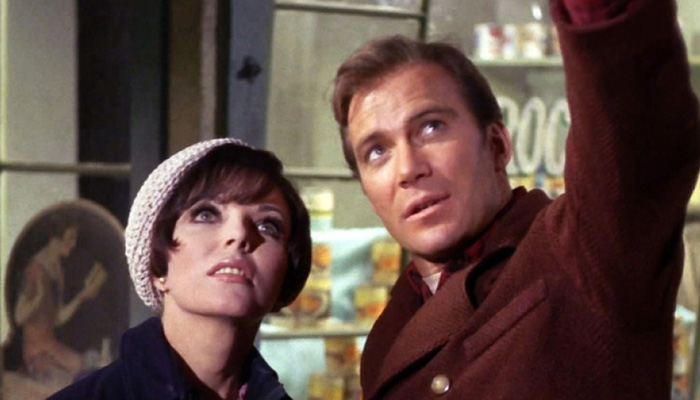
Star Trek IV: The Voyage Home

Star Trek: The Next Generation

Star Trek Generations

Star Trek: First Contact

Star Trek: Deep Space Nine
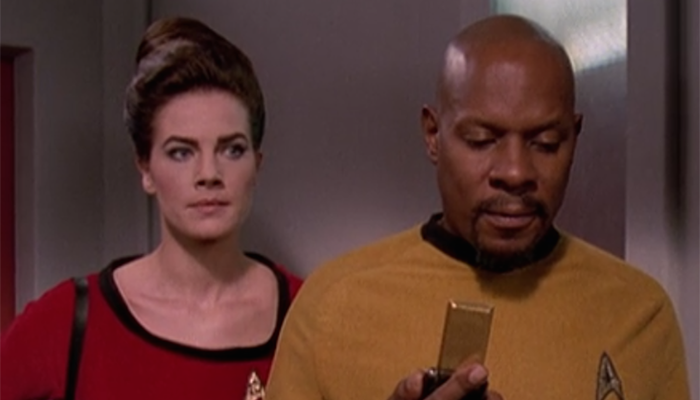
Star Trek: Voyager

Star Trek: Enterprise
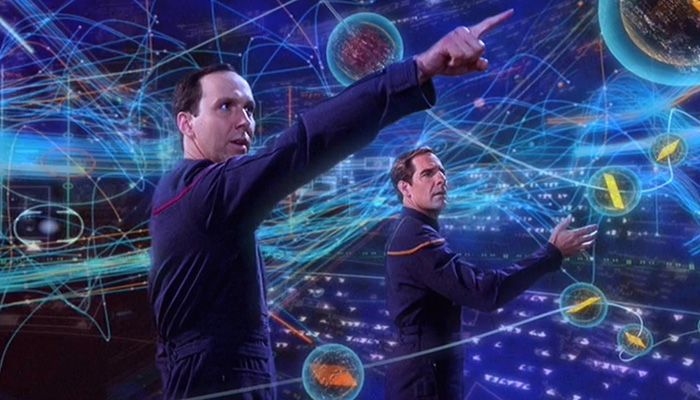
Star Trek: Discovery

Related Content

'Ghost Adventures' Returns With An All-New Season This May

Couple Talk About Their Three-Way Relationship With A Ghost On 'This Morning'

Revisiting Jon Ronson's 'For The Love Of... Ghosts'

T+E Annual 'Spring Shivers' Programming Event Unveils A Spooktacular Must-See TV Lineup

All-New Season Of 'Ghost Adventures: House Calls' Premieres In April

Celebrity Help! My House Is Haunted Series 3 Quiz

Yvette Fielding Tells 'This Morning' Hosts She'd 'Love' To Investigate Television Centre

Celebrity Ghost Stories Quiz

Paul Chuckle Communicates With His Late Brother Barry During A TV Ghost Hunt At His Home

Spirit Of Prince Diana Delivers Message To Paul Burrell On Paranormal TV Show

'Unexplained: Caught On Camera' Series 4 Quiz

'Celebrity Help! My House Is Haunted' Returns In January For Series 3
Daily horoscopes.

You'll have to learn about a healthy lifestyle plan and sooner is better than later. Investigating healthier diets and exercise programs might not be on the top of the list right now, but you may be forced to look at... Read More
Featured Content
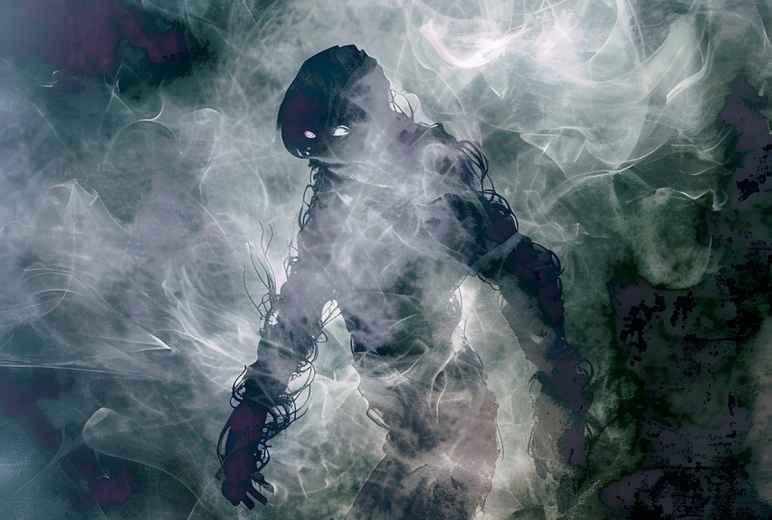
Why Ghost Hunters Talk About 'Entities' So Much
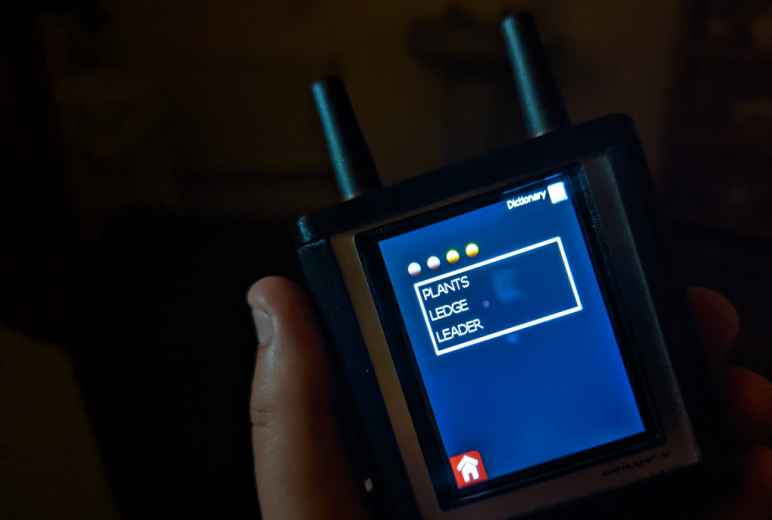
How Devices With Built-In Word Banks Claim To Decipher Spirit Messages
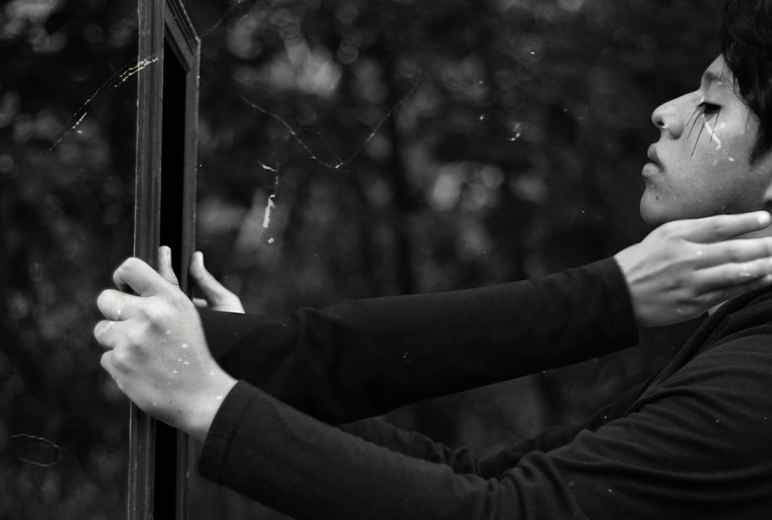
Spirit Walk-Ins: A Peaceful Exchange Of Souls Or A Forced Possession
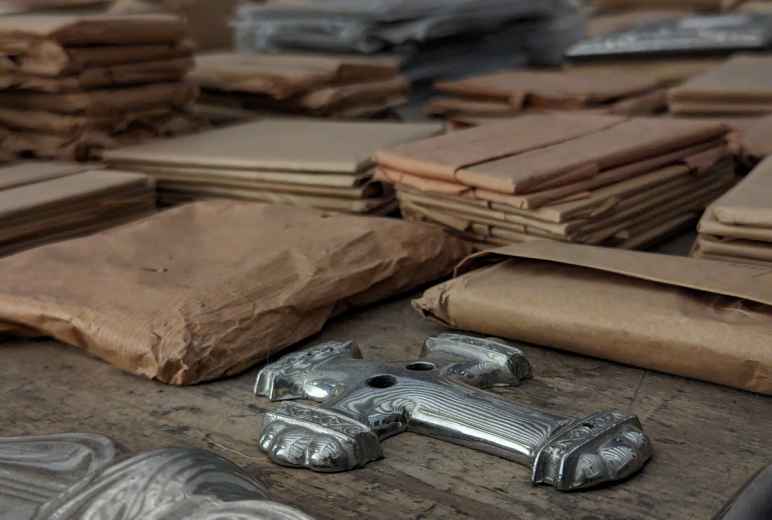
How Trigger Objects Are Used To Help Detect A Ghostly Presence
You may also like.

What Therapeutic Touch Claims To Do & How It's Said To Work

Telepathy & The Potential For Mind-To-Mind Communication
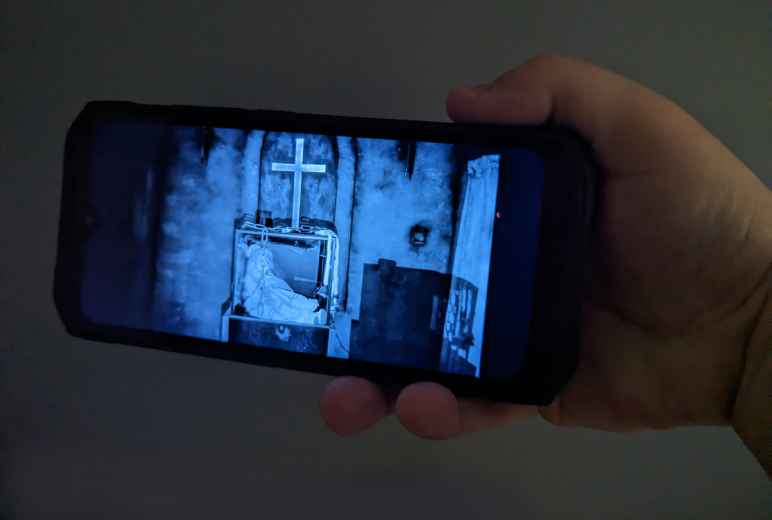
Spirit Photography & Its Role In Paranormal Investigations

What Shadow Figures Are And Why They're Haunting Us
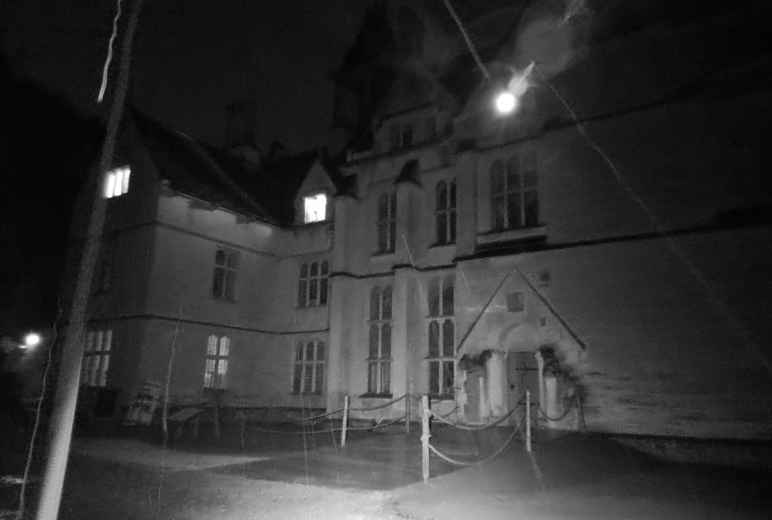
My Ghost-Hunting Return To Woodchester Mansion

How To Conduct A Séance & Master The Basics Of Spirit Communication
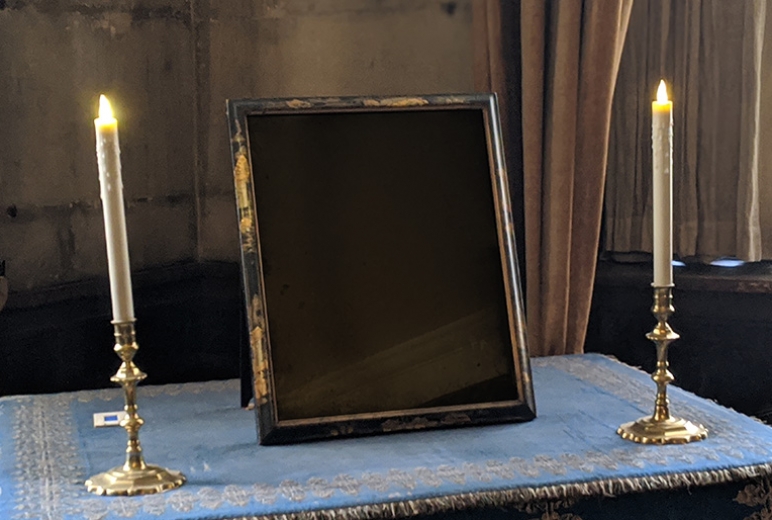
Scrying: A Magic Mirror Or A Load Of Crystal Balls

How April's Incessant Rainfall Might Be Fuelling Ghostly Encounters
- Updated Terms of Use
- New Privacy Policy
- Your Privacy Choices
- Closed Caption Policy
- Accessibility Statement
This material may not be published, broadcast, rewritten, or redistributed. ©2024 FOX News Network, LLC. All rights reserved. Quotes displayed in real-time or delayed by at least 15 minutes. Market data provided by Factset . Powered and implemented by FactSet Digital Solutions . Legal Statement . Mutual Fund and ETF data provided by Refinitiv Lipper .
NASA re-establishes communication with Voyager 1 interstellar spacecraft that went silent for months
Voyager 1 is located more than 15 billion miles away from earth.

NASA’s Perseverance rover on Mars captures dust devil
The Mars rover Perseverance captured a dust devil moving across the rim of a crater. Credit: NASA
NASA and Voyager 1 are communicating back and forth again, after the most distant human-made object in space stopped sending usable data back to the space agency nearly five months ago.
NASA’s Jet Propulsion Laboratory said Voyager 1, which is more than 15 billion miles away from Earth, stopped sending readable data back to scientists on Nov. 14, 2023, though mission controllers could still see the spacecraft was receiving commands and operating as intended.
The Southern California-based engineering team responsible for Voyager 1 investigated the problem and learned the issue was connected to one of the spacecraft’s three onboard computers, which is called the Flight Data Subsystem (FDS).
The FDS packages the data collected by the spacecraft before sending it back to earth.
RARE STAR EXPLOSION EXPECTED TO BE ‘ONCE-IN-A-LIFETIME VIEWING OPPORTUNITY,’ NASA OFFICIALS SAY

NASA’s Voyager 1 spacecraft is depicted in this artist’s concept of traveling through interstellar space, or the space between stars, which it entered in 2012. (Credit: NASA/JPL-Caltech)
Engineers discovered the chip responsible for storing a portion of the FDS memory was faulty, making the code unusable.
Had the spacecraft been located on Earth, engineers would be able to go in and replace a chip, but because it is in interstellar space, engineers needed to figure out a way to move the affected code somewhere else in the FDS memory.
The code is so large that there is not a single location to store the entire section of the code. So, engineers divided the affected code into sections and planned to move them to various locations in the FDS.
NASA PUBLISHES NEVER-BEFORE-SEEN PHOTOS OF ‘RAVIOLI’ MOON ORBITING SATURN

After receiving data about the health and status of Voyager 1 for the first time in five months, members of the Voyager flight team celebrated in a conference room at NASA’s Jet Propulsion Laboratory on April 20. (Credit: NASA/JPL-Caltech )
Engineers also had to make sure the code worked together as a whole after being moved.
Once the code was reconfigured, engineers transmitted the changes to the FDS memory on April 18.
The signal takes about 22.5 hours to travel through space until it reaches Voyager 1, and then another 22.5 hours for a signal to come back to earth.
VOYAGER 1 DETECTS ‘HUM’ WHILE IN INTERSTELLAR SPACE: REPORT
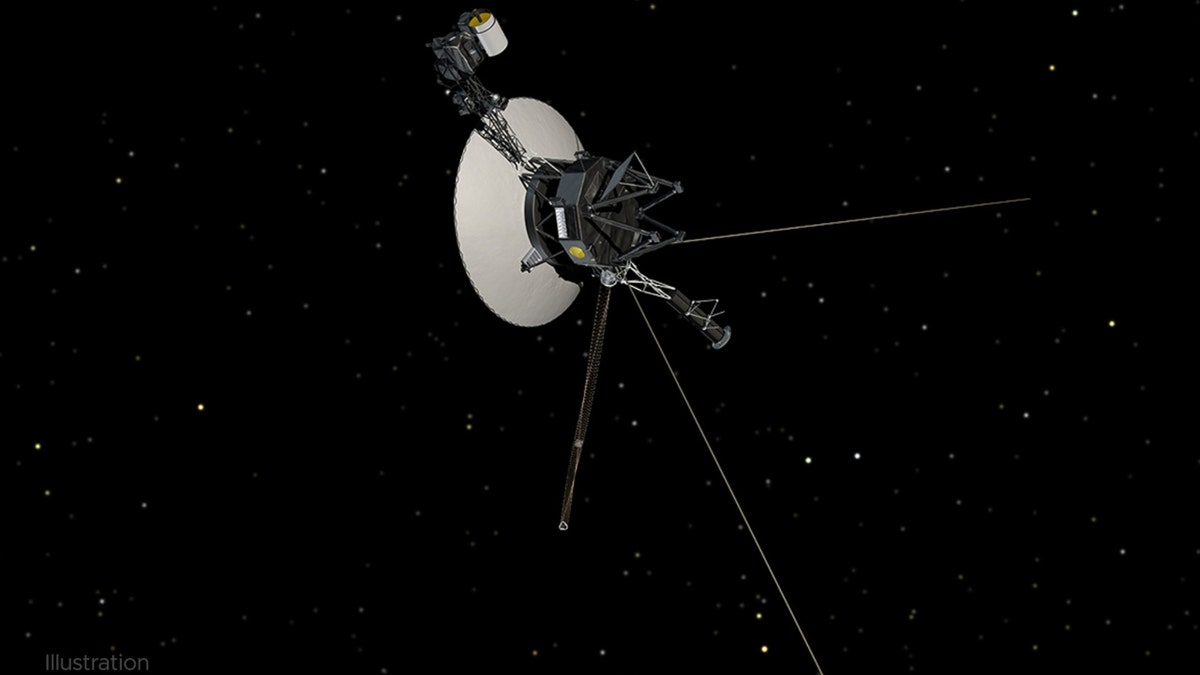
NASA’s Voyager 1 spacecraft, shown in this illustration, has been exploring our solar system since 1977, along with its twin, Voyager 2. (Credit: NASA/JPL-Caltech)
On April 20, the mission team received a response from Voyager 1 and confirmed the modification worked. As a result, engineers now have the ability to check the health and status of the spacecraft.
In the coming months, the team plans to move and adjust additional portions of the FDS software that was affected, including portions that send scientific data back to mission control.
Voyager 1′s odyssey began in 1977 when the spacecraft and its twin, Voyager 2, were launched on a tour of the gas giant planets of the solar system.
CLICK HERE TO GET THE FOX NEWS APP
After beaming back dazzling postcard views of Jupiter’s giant red spot and Saturn’s shimmering rings, Voyager 2 hopscotched to Uranus and Neptune . Meanwhile, Voyager 1 used Saturn as a gravitational slingshot to power itself past Pluto.
Greg Wehner is a breaking news reporter for Fox News Digital.
Story tips and can be sent to [email protected] and on Twitter @GregWehner.

Get a daily look at what’s developing in science and technology throughout the world.
You've successfully subscribed to this newsletter!
- Today's news
- Reviews and deals
- Climate change
- 2024 election
- Fall allergies
- Health news
- Mental health
- Sexual health
- Family health
- So mini ways
- Unapologetically
- Buying guides
Entertainment
- How to Watch
- My watchlist
- Stock market
- Biden economy
- Personal finance
- Stocks: most active
- Stocks: gainers
- Stocks: losers
- Trending tickers
- World indices
- US Treasury bonds
- Top mutual funds
- Highest open interest
- Highest implied volatility
- Currency converter
- Basic materials
- Communication services
- Consumer cyclical
- Consumer defensive
- Financial services
- Industrials
- Real estate
- Mutual funds
- Credit cards
- Credit card rates
- Balance transfer credit cards
- Business credit cards
- Cash back credit cards
- Rewards credit cards
- Travel credit cards
- Checking accounts
- Online checking accounts
- High-yield savings accounts
- Money market accounts
- Personal loans
- Student loans
- Car insurance
- Home buying
- Options pit
- Investment ideas
- Research reports
- Fantasy football
- Pro Pick 'Em
- College Pick 'Em
- Fantasy baseball
- Fantasy hockey
- Fantasy basketball
- Download the app
- Daily fantasy
- Scores and schedules
- GameChannel
- World Baseball Classic
- Premier League
- CONCACAF League
- Champions League
- Motorsports
- Horse racing
- Newsletters
New on Yahoo
- Privacy Dashboard
- Buying Guides
NASA's Voyager 1 sending readable data back to Earth for 1st time in 5 months
After more than five months without contact, NASA has finally reconnected with Voyager 1, the farthest spacecraft from Earth.
NASA's Jet Propulsion Lab (JPL) said Voyager 1 had not been sending readable data back to Earth since Nov. 14, 2023, despite the spacecraft still receiving mission controller commands.
In December 2023, the JPL announced the problem was with one of Voyager 1's onboard computers called the flight data subsystem (FDS). Engineers attempted to restart the computer, but the problem persisted, NASA said.
MORE: NASA asks for help studying Uranus and Neptune as it prepares to capture new images
However, the JPL announced this week that Voyager 1 had resumed sending engineering updates to Earth.
Engineers pinpointed the problem earlier this month, NASA said: A chip responsible for storing part of the computer's memory had become corrupted, making the data unreadable. The team was unable to repair the chip and decided the affected code needed to be stored elsewhere in the FDS memory, but no single location was large enough to do so, the JPL said in a release Monday.
The team "devised a plan to divide the affected code into sections and store those sections in different places in the FDS," the release read. "To make this plan work, they also needed to adjust those code sections to ensure, for example, that they all still function as a whole."
The code that packages Voyager 1's engineering data was the first to be sent to its new location on April 18. The JPL said it takes 22.5 hours for a radio signal to reach Voyager 1 and another 22.5 hours for the signal to come back to Earth. When the team heard from Voyager 1 on April 20, they knew the fix was a success, the JPL said.
"Hi, it's me. - V1," the X account for Voyager 1 posted on Monday afternoon.
Over the next few weeks, more portions of the FDS software will be relocated and the team will work to enable the spacecraft to begin returning science data again, the JPL said.
MORE: NASA says it's revising the Mars Sample Return mission due to cost, long wait time
Voyager 1 was launched in September 1977 under the Voyager program to study the farther planets of the solar system and interstellar space. Voyager 1 entered interstellar space in 2012 becoming the first man-made object to exit the solar system.
Meanwhile, its twin spacecraft, Voyager 2, continues to "operate normally," according to the JPL. It reached interstellar space in 2018 and is the second-farthest spacecraft from Earth.
NASA's Voyager 1 sending readable data back to Earth for 1st time in 5 months originally appeared on abcnews.go.com
Recommended Stories
Nba playoffs: heat set franchise playoff record for 3-pointers during series-evening win over celtics.
Miami hit 23 3-pointers during their Game 2 victory.
Xaira, an AI drug discovery startup, launches with a massive $1B, says it's 'ready' to start developing drugs
Advances in generative AI have taken the tech world by storm. Biotech investors are making a big bet that similar computational methods could revolutionize drug discovery. On Tuesday, ARCH Venture Partners and Foresite Labs, an affiliate of Foresite Capital, announced that they incubated Xaira Therapeutics and funded the AI biotech with $1 billion.
Cubs place Cody Bellinger on IL due to rib fracture, call up top prospect Pete Crow-Armstrong
Cody Bellinger ran into a brick wall. It didn't end well.
Bengals All-Pro Trey Hendrickson reportedly joins Tee Higgins in requesting trade
Hendrickson is coming off a career-high 17.5-sack season.
What to do when your credit card application is denied
After receiving a credit card rejection, take these steps to improve your application and get approved in the future.
College Football Playoff will not consider Army-Navy game in selection process
The decision ends one of the more pressing issues for the CFP Management Committee this week in Dallas.
2024 NFL Draft Care/Don't Care: Minnesota's QB conundrum, the WR bonanza and more
Fantasy football analyst Matt Harmon reveals his final thoughts on the eve of the 2024 NFL Draft, including what the Vikings will do at the most important position.
'Baby Reindeer' is based on Richard Gadd's real life. He's asking internet sleuths to stop trying to expose the people behind the characters.
The Netflix limited series is about Gadd’s experience with a stalker and, separately, being a victim of sexual violence. He’s asking viewers not to “speculate on who any of the real life people [behind the characters] could be.”
TikTok Lite axes ‘addictive as cigarettes’ reward-to-watch feature under the EU’s watchful eye
The EU has effectively vanquished a TikTok feature that Europe’s digital commissioner described as “toxic” and “addictive as cigarettes.” TikTok owner ByteDance said on Wednesday that TikTok Lite’s reward-to-watch feature would be suspended.
Pro-Palestinian demonstrations have spread across college campuses. What exactly do protesters want?
Pro-Palestinian demonstrations continue to grow at a number of major U.S. universities. They have all made it clear that they are all against Israel's war with Hamas in Gaza, but what can they really do about the conflict in the Middle East from a college campus?Here's a look at what protesters are really demanding from their demonstrations.
Stock market today: Tesla surges 12%, stocks go nowhere amid earnings rush
Tesla's surge is putting Big Tech earnings center stage as investors look to megacaps to lift stocks.
Meta stock plummets 15% after second quarter outlook disappoints
Meta reported its Q1 earnings after the bell, beating analysts' expectations on the top and bottom, but a disappointing Q2 forecast sent shares falling.
Trump Media CEO urges House GOP leaders to address 'potential manipulation' of DJT stock
The company recently attempted to fend off short sellers by advising investors on ways to prevent their shares from being loaned for short-interest positions.
Reggie Bush finally gets his Heisman back and Colorado's Dylan Edwards hits the portal
Dan Wetzel, Ross Dellenger, and SI's Pat Forde react to the news of Reggie Bush getting his Heisman trophy back, Dylan Edwards hitting the portal, and their favorite NFL Draft memories.
PUBG will take a nostalgia-infused trip back to its first map in May
PUBG: Battlegrounds is somehow old enough to evoke nostalgia. The pioneering battle royale game will recreate the old-school battlefield from the game’s inception for a limited two-week run in May and June.
Save up to 50% on a Rove dash cam thanks to this killer spring sale
Adding a dash cam to your car can bring you priceless peace-of-mind on the road and this spring sale on Rove dash cams could save you hundreds on a new one.
Lisa Vanderpump wore these trendy $1,200 heels for her villa tour — but you can get the look for $60
We found affordable alternatives to the Bravo star's sparkly Mach & Mach pumps at Amazon.
Way Day 2024: Everything you need to know about Wayfair's savings blowout
Mark your calendar: Way Day kicks off on Saturday, May 4 and runs through Monday, May 6. Plus, deals to shop now!
Bluey grows up in 'Surprise!' For some parents, seeing her change hits home.
The touching episode has parents feeling complicated emotions about the future of the show — and about their own kids growing up.
Reggie Bush's Heisman redemption and the fallacy of amateurism
Amateurism is dead. Even the self-important Heisman Trust knows it after Reggie Bush's reinstatement. Now it's the NCAA's turn to take a symbolic step.
Voyager 1 is sending data back to Earth for the first time in 5 months
For the first time in five months, NASA engineers have received decipherable data from Voyager 1 after crafting a creative solution to fix a communication problem aboard humanity's most distant spacecraft in the cosmos.
Voyager 1 is currently about 15 billion miles (24 billion kilometers) away, and at 46 years old, the probe has shown multiple quirks and signs of aging in recent years.
The latest issue experienced by Voyager 1 first cropped up in November 2023, when the flight data system's telemetry modulation unit began sending an indecipherable repeating pattern of code.
Voyager 1's flight data system collects information from the spacecraft's science instruments and bundles it with engineering data that reflects its current health status. Mission control on Earth receives that data in binary code, or a series of ones and zeroes.
But since November, Voyager 1's flight data system had been stuck in a loop. While the probe has continued to relay a steady radio signal to its mission control team on Earth over the past few months, the signal did not carry any usable data.
The mission team received the first coherent data about the health and status of Voyager 1's engineering systems on April 20. While the team is still reviewing the information, everything they've seen so far suggests Voyager 1 is healthy and operating properly.
"Today was a great day for Voyager 1," said Linda Spilker, Voyager project scientist at JPL, in a statement Saturday. "We're back in communication with the spacecraft. And we look forward to getting science data back."
The breakthrough came as the result of a clever bit of trial and error and the unraveling of a mystery that led the team to a single chip.
Troubleshooting from billions of miles away
After discovering the issue, the mission team attempted sending commands to restart the spacecraft's computer system and learn more about the underlying cause of the problem.
The team sent a command called a "poke" to Voyager 1 on March 1 to get the flight data system to run different software sequences in the hopes of finding out what was causing the glitch.
On March 3, the team noticed that activity from one part of the flight data system stood out from the rest of the garbled data. While the signal wasn't in the format the Voyager team is used to seeing when the flight data system is functioning as expected, an engineer with NASA's Deep Space Network was able to decode it.
The Deep Space Network is a system of radio antennae on Earth that help the agency communicate with the Voyager probes and other spacecraft exploring our solar system.
The decoded signal included a readout of the entire flight data system's memory.
By investigating the readout, the team determined the cause of the issue: 3% of the flight data system's memory is corrupted. A single chip responsible for storing part of the system's memory, including some of the computer's software code, isn't working properly. While the cause of the chip's failure is unknown, it could be worn out or may have been hit by an energetic particle from space, the team said.
The loss of the code on the chip caused Voyager 1's science and engineering data to be unusable.
Since there was no way to repair the chip, the team opted to store the affected code from the chip elsewhere in the system's memory. While they couldn't pinpoint a location large enough to hold all of the code, they were able to divide the code into sections and store it in different spots within the flight data system.
"To make this plan work, they also needed to adjust those code sections to ensure, for example, that they all still function as a whole," according to an update from NASA. "Any references to the location of that code in other parts of the (flight data system) memory needed to be updated as well."
After determining the code necessary for packaging Voyager 1's engineering data, engineers sent a radio signal to the probe commanding the code to a new location in the system's memory on April 18.
Given Voyager 1's immense distance from Earth, it takes a radio signal about 22.5 hours to reach the probe, and another 22.5 hours for a response signal from the spacecraft to reach Earth.
On April 20, the team received Voyager 1's response indicating that the clever code modification had worked, and they could finally receive readable engineering data from the probe once more.
Exploring interstellar space
Within the coming weeks, the team will continue to relocate other affected parts of the system's software, including those responsible for returning the valuable science data Voyager 1 is collecting.
Initially designed to last five years, the Voyager 1 and its twin, Voyager 2, launched in 1977 and are the longest-operating spacecraft in history. Their exceptionally long life spans mean that both spacecraft have provided additional insights about our solar system and beyond after achieving their preliminary goals of flying by Jupiter, Saturn, Uranus and Neptune decades ago.
The probes are currently venturing through uncharted cosmic territory along the outer reaches of the solar system. Both are in interstellar space and are the only spacecraft ever to operate beyond the heliosphere, the sun's bubble of magnetic fields and particles that extends well beyond the orbit of Pluto.
Voyager 2, which is operating normally, has traveled more than 12.6 billion miles (20.3 billion kilometers) from our planet.
Over time, both spacecraft have encountered unexpected issues and dropouts, including a seven-month period in 2020 when Voyager 2 couldn't communicate with Earth. In August 2023, the mission team used a long-shot "shout" technique to restore communications with Voyager 2 after a command inadvertently oriented the spacecraft's antenna in the wrong direction.
The team estimates it's a few weeks away from receiving science data from Voyager 1 and looks forward to seeing what that data contains.
"We never know for sure what's going to happen with the Voyagers, but it constantly amazes me when they just keep going," said Voyager Project Manager Suzanne Dodd, in a statement. "We've had many anomalies, and they are getting harder. But we've been fortunate so far to recover from them. And the mission keeps going. And younger engineers are coming onto the Voyager team and contributing their knowledge to keep the mission going."
(The-CNN-Wire & 2023 Cable News Network, Inc., a Time Warner Company. All rights reserved.)
Related Topics
- U.S. & WORLD

April's full Pink Moon: When and where to see it

A new weather threat emerges for eclipse viewers to worry about

New calculations show popular eclipse maps might be off track

Millions of Americans witness a rare total solar eclipse
Top stories.

Union says packages at risk as 600 USPS workers robbed last year
- 43 minutes ago

Judge won't dismiss lawsuits against Travis Scott over Astroworld
- 2 hours ago

Houston mother-son accused of stealing more than $1M in scheme

Man accepts plea deal in 2022 killing of worker over just $2

Family wasn't notified when organ transplant program was suspended
Houston Public Works plans to send 'set rate' to reduce high bills
- 3 hours ago
Harris County Judge says she hasn't met with Mayor John Whitmire
Longtime NFL general manager looks to Texans draft night
- 21 minutes ago
NASA hears from Voyager 1, the most distant spacecraft from Earth, after months of quiet
NASA has finally heard back from Voyager 1 in a way that makes sense
CAPE CANAVERAL, Fla. -- NASA has finally heard back from Voyager 1 again in a way that makes sense.
The most distant spacecraft from Earth stopped sending back understandable data last November. Flight controllers traced the blank communication to a bad computer chip and rearranged the spacecraft’s coding to work around the trouble.
NASA’s Jet Propulsion Laboratory in Southern California declared success after receiving good engineering updates late last week. The team is still working to restore transmission of the science data.
It takes 22 1/2 hours to send a signal to Voyager 1, more than 15 billion miles (24 billion kilometers) away in interstellar space. The signal travel time is double that for a round trip.
Contact was never lost, rather it was like making a phone call where you can’t hear the person on the other end, a JPL spokeswoman said Tuesday.
Launched in 1977 to study Jupiter and Saturn, Voyager 1 has been exploring interstellar space — the space between star systems — since 2012. Its twin, Voyager 2, is 12.6 billion miles (20 billion kilometers) away and still working fine.
The Associated Press Health and Science Department receives support from the Howard Hughes Medical Institute’s Science and Educational Media Group. The AP is solely responsible for all content.
Top Stories

What witnesses said about Trump's handling of classified info while president
- Apr 24, 4:58 PM

As Trump battles for immunity, question resurfaces about assassinating rivals
- Apr 24, 4:04 PM

Airlines required to refund passengers for canceled, delayed flights
- Apr 24, 11:06 AM

Plastic bags from Walmart US recycling tracked to facilities in Southeast Asia
- Apr 23, 9:48 PM

Secret Service prepares for if Trump is jailed for contempt in hush money case
- Apr 23, 4:16 PM
ABC News Live
24/7 coverage of breaking news and live events
- Cast & crew
- User reviews

A member of a league of time travelers and a boy travel through time repairing errors in world history. A member of a league of time travelers and a boy travel through time repairing errors in world history. A member of a league of time travelers and a boy travel through time repairing errors in world history.
- James D. Parriott
- Jon-Erik Hexum
- Meeno Peluce
- David Cadiente
- 39 User reviews
- 6 Critic reviews
- 1 nomination
Episodes 20

- Phineas Bogg

- Jeffrey Jones
- 1st Pirate …

- Merriwether Lewis …

- Bartender …

- Wilbur Wright

- Charles Lindbergh

- Teddy Roosevelt

- Abraham Lincoln

- Reverend Parris

- Lawrence of Arabia

- George Washington

- Lucky Luciano

- Maffeo Polo
- Lizzie Palmer
- All cast & crew
- Production, box office & more at IMDbPro
More like this

Did you know
- Trivia After leaving his acting career behind, Meeno Peluce became a high school history teacher.
- Goofs In the early episodes, whenever the Voyagers are in time jump, neither their clothes nor number of personnel match when they jumped or land.
[opening narration]
Phineas Bogg : We travel through time to help history along, give it a push where it's needed. When the Omni's red, it means history's wrong. Our job's to get everything back on track.
- Crazy credits During the credits, we hear Meeno Peluce, one of the cast members, say, "If you would like to learn more about [names of three famous things pertaining to the episode], take a voyage down to your public library. It's all in books."
- Connections Edited from The Buccaneer (1958)
User reviews 39
- Feb 9, 2007
- How many seasons does Voyagers! have? Powered by Alexa
- October 3, 1982 (United States)
- United States
- Official Site
- Die Zeitreisenden
- Colonial Street, Backlot, Universal Studios - 100 Universal City Plaza, Universal City, California, USA
- James D. Parriott Productions
- Scholastic Productions
- Universal Television
- See more company credits at IMDbPro
Technical specs
- Runtime 1 hour
Related news
Contribute to this page.

- See more gaps
- Learn more about contributing
More to explore

Recently viewed
NASA hears from Voyager 1, the most distant spacecraft from Earth, after months of quiet

CAPE CANAVERAL, Fla. (AP) — NASA has finally heard back from Voyager 1 again in a way that makes sense.
The most distant spacecraft from Earth stopped sending back understandable data last November. Flight controllers traced the blank communication to a bad computer chip and rearranged the spacecraft’s coding to work around the trouble.
NASA’s Jet Propulsion Laboratory in Southern California declared success after receiving good engineering updates late last week. The team is still working to restore transmission of the science data.
It takes 22 1/2 hours to send a signal to Voyager 1, more than 15 billion miles (24 billion kilometers) away in interstellar space. The signal travel time is double that for a round trip.
Contact was never lost, rather it was like making a phone call where you can’t hear the person on the other end, a JPL spokeswoman said Tuesday.
Launched in 1977 to study Jupiter and Saturn, Voyager 1 has been exploring interstellar space — the space between star systems — since 2012. Its twin, Voyager 2, is 12.6 billion miles (20 billion kilometers) away and still working fine.
The Associated Press Health and Science Department receives support from the Howard Hughes Medical Institute’s Science and Educational Media Group. The AP is solely responsible for all content.
Copyright 2024 The Associated Press. All rights reserved.

Shots fired Sunday evening on Whittlesey Blvd. in Columbus

16-year-old dead after being struck by vehicle after shift at Wendy’s in Columbus

1 dead, 1 injured in overnight shooting on Macon Rd. near Lake Shore Rd.

Two Years Later: Mother and murder suspect in Kamarie Holland case plead guilty to charges

Lanes reopen on I-185 after being shut down due to live electrical wires on roadway
Latest news.

Three Columbus public pools expected to reopen in upcoming months

Tips to protect yourself from landscaping schemes

Road Construction Impacts Businesses on 13th Ave in Columbus

High school junior scores perfect ACT, gets into prestigious MIT program

Student scores perfect ACT, gets into MIT program

IMAGES
VIDEO
COMMENTS
Season 3, Episode 8-9: "Future's End: Parts 1 & 2". Voyager is attacked by a ship from the future and is accidentally sucked into the 20th century. The crew have to juggle numerous missions ...
Future's End: Directed by David Livingston. With Kate Mulgrew, Robert Beltran, Roxann Dawson, Jennifer Lien. A timeship from the future who tries to stop Voyager gets thrown with Voyager into the twentieth century. His timeship is found in the 1960's and Voyager finds a company that has benefited from its technology exists in 1996.
Relativity: Directed by Allan Eastman. With Kate Mulgrew, Robert Beltran, Roxann Dawson, Robert Duncan McNeill. Federation time ship Capt Braxton pulls Seven out of her time to help identify and destroy a bomb planted aboard Voyager.
Future's End. " Future's End " is a two-part episode from the third season of the American science fiction television series Star Trek: Voyager, the eighth and ninth of the season and the 50th and 51st overall. "Future's End" made its debut on American television in November 1996 on the UPN network in two separate broadcasts, on November 6 and ...
In 2015, Den of Geek suggested "Shattered" for a binge-watching guide that focused on Star Trek: Voyager episodes featuring time travel. In 2018, CBR ranked this one of the top-twenty time travel themed episodes of all Star Trek series. In 2021, The Digital Fix said this was a "good episode" and were happy with the cameos and time shifting.
Relativity" was noted by SYFY Wire as 14 of 15 of the top Star Trek episodes involving time travel in 2016. ... Voyager episodes featuring time travel. Releases "Relativity" was released on LaserDisc in Japan on June 22, 2001, as part of 5th Season vol.2, which included episodes from "Dark Frontier" to "Equinox, Part I". The episode had two ...
And despite time travel being a popular narrative trope in Star Trek, the show never failed to find new ways to explore and subvert it. "Relativity" is a fun, ticking-clock caper that sends former Borg drone Seven of Nine (Jeri Ryan) back in time to prevent the destruction of Voyager. ... Voyager's 100th episode is one of the greatest ever ...
Season 1, Episode 14: "Faces". "Faces" is a bold episode to include in the first season of a show. Voyager's away team is captured by the Vidiians, a species that have advanced medical ...
Time and Again: Directed by Les Landau. With Kate Mulgrew, Robert Beltran, Roxann Dawson, Jennifer Lien. The Voyager crew discovers a planet which recently suffered a horrific catastrophe. Upon investigation, Janeway and Paris are sent back in time before the disaster and are faced with the decision of whether to try to stop it.
Star Trek Voyager - Captain La Forge of the USS Challenger "Timeless". Watch on. Showrunner Brannon Braga's love for the high concept is evident in this episode that starts 15 years in the future ...
Seven of Nine is recruited by a starship from the 29th century to save Voyager from being destroyed in the past. In 2371, Captain Janeway beams aboard the starship USS Voyager during the final phases of the Voyager's construction at Utopia Planitia. Admiral Patterson, who had been her calculus instructor at Starfleet Academy, is there to greet her with a pop quiz. After Janeway answers all of ...
Help. S5 E24 46M TV-PG. Seven is recruited by Captain Braxton of the 29th century timeship Relativity to go back in time and stop an unknown culprit from destroying Voyager.
Star Trek loves a good time loop and here are 5 of the best. Time loop stories are a classic science fiction premise Star Trek excels at. Star Trek: Enterprise and Voyager had excellent time loop episodes, but The Next Generation's "Cause and Effect" is the best. Star Trek: Discovery had two time loop episodes, "Magic to Make the Sanest Man Go ...
Watch Full Episodes. Kathryn Janeway is the captain of a starship that is lost in space and must travel across an unexplored region of the galaxy to find its way back home. Starring: Kate Mulgrew, Robert Beltran, Roxann Dawson, Robert Duncan McNeill, Ethan Phillips. TRY IT FREE.
Some of the Voyager crew's ongoing problems with time travel are kicked off in Future's End, while Before And After is a rather good backwards episode. Flashback , as the title implies ...
Calling this episode "complicated" would be a mild understatement. It's hard to analyze a time travel episode that consists of intricate paradoxes, but I will nevertheless try it. 1. "Relativity" begins at Utopia Planitia when Voyager is just being prepared for the first mission in 2371.
Time travel features in over 50 episodes of Star Trek and in four of the movies, making it one of the franchise's most commonly used storytelling mechanics. This list includes all episodes the television series and the movies with time travel plots, from the original series through to 'The Next Generation', 'Deep Space Nine' and 'Voyager', as ...
This is an episode list for the science-fiction television series Star Trek: Voyager, which aired on UPN from January 1995 through May 2001. This is the fifth television program in the Star Trek franchise, and comprises a total of 168 (DVD and original broadcast) or 172 (syndicated) episodes over the show's seven seasons. Four episodes of Voyager ("Caretaker", "Dark Frontier", "Flesh and Blood ...
The perfect mix of high concept sci-fi and emotional character growth, "All Good Things" remains the gold standard for series finales, and a great time travel yarn. 3. "Trials and Tribble ...
Voyager 's finale echoes many structural elements and narrative touchstones of that classic episode, including: time travel, a temporal anomaly requiring closure using a beam from the main ...
Timeless: Directed by LeVar Burton. With Kate Mulgrew, Robert Beltran, Roxann Dawson, Robert Duncan McNeill. A miscalculation by Ensign Kim causes a fatal crash during Voyager's first test with slipstream travel. Fifteen years in the future, survivors Chakotay, Kim and The Doctor attempt to send a message back in time to prevent the tragedy.
Greg Wehner is a breaking news reporter for Fox News Digital. Story tips and can be sent to [email protected] and on Twitter @GregWehner. NASA re-established communication with Voyager 1, an ...
The code that packages Voyager 1's engineering data was the first to be sent to its new location on April 18. The JPL said it takes 22.5 hours for a radio signal to reach Voyager 1 and another 22. ...
WASHINGTON — NASA has finally heard back from Voyager 1 again in a way that makes sense. Voyager 1, the most distant spacecraft in human history, had stopped sending usable data back to space engineers about five months ago. Flight controllers traced the blank communication to a bad computer chip and rearranged the spacecraft's coding to ...
"Timeless" is the sixth episode of the fifth season of Star Trek: Voyager and was also the series' 100th episode. The episode was directed by LeVar Burton, who was also featured in a cameo appearance as his Star Trek: The Next Generation character Geordi La Forge.. The episode also marks an important turning point among the series when Janeway notes in her personal log the changing perspective ...
And younger engineers are coming onto the Voyager team and contributing their knowledge to keep the mission going." (The-CNN-Wire & 2023 Cable News Network, Inc., a Time Warner Company. All rights ...
It takes 22 1/2 hours to send a signal to Voyager 1, more than 15 billion miles (24 billion kilometers) away in interstellar space. The signal travel time is double that for a round trip. Contact ...
Voyagers!: Created by James D. Parriott. With Jon-Erik Hexum, Meeno Peluce, David Cadiente, Stephen Liska. A member of a league of time travelers and a boy travel through time repairing errors in world history.
Time and Again (Star Trek: Voyager) Time Squared (Star Trek: The Next Generation) Time's Arrow (Star Trek: The Next Generation) Time's Orphan. Timeless (Star Trek: Voyager) Timescape (Star Trek: The Next Generation) Tomorrow and Tomorrow and Tomorrow (Star Trek: Strange New Worlds) Tomorrow Is Yesterday. Trials and Tribble-ations.
It takes 22 1/2 hours to send a signal to Voyager 1, more than 15 billion miles (24 billion kilometers) away in interstellar space. The signal travel time is double that for a round trip.